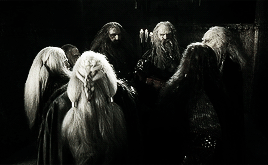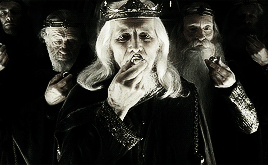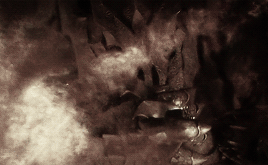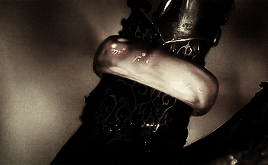Tar_Murazor
Tar joined
Gû kîbum kelkum-ishi, burzum-ishi. Akha - gûm-ishi ashi gurum. Nubin sherkuk, rakhizinash, matizinashûk, matizin Umbrûk.
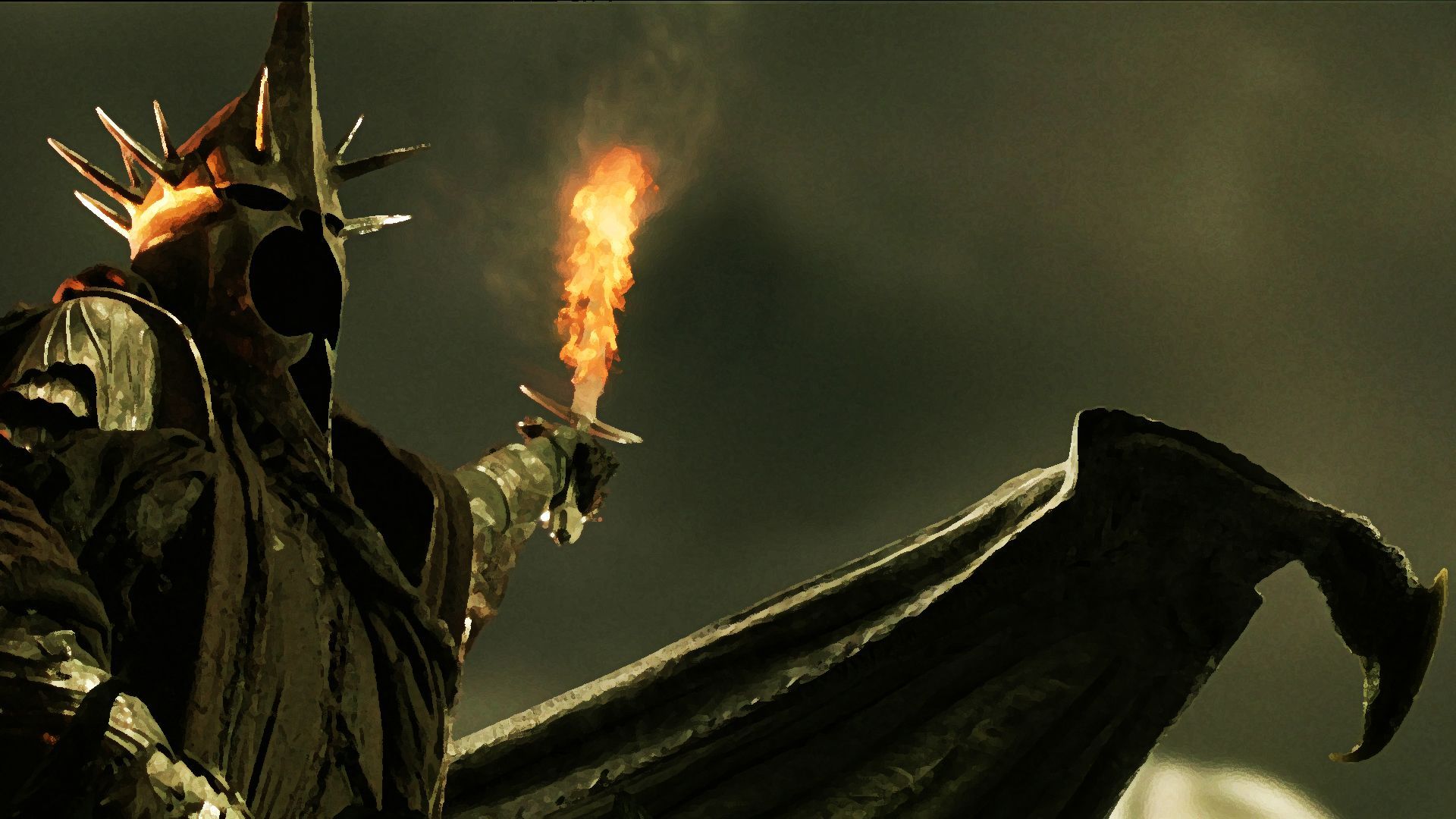
The Númenórean Er-Mûrazôr (Ad. “Prince of Black Fire”) was the most gifted and powerful of the many great Lords of Númenor. Although only a prince, his might outshone all but a few of Númenor’s Kings and, in the end, he lived longer than any of theAdan. Mûrazôr’s tale covers over six and a half millennia and is one of Man’s great tragedies.
The Black Prince was born in S.A. 1820 in the port city of Anduniein the province of Andustar on the island of Númenor (Andor). As the second son of King Tar-Ciryatan (Q. “Ship-builder”) and the younger brother of (Tar-) Atanamir the Great, he traced his lineage to the first King, Elros Tar-Minyatur. His mother gave him the nameTindomul (Q. “Twilight Son”), for he was born during a solar eclipse and his hair was blacker than any she had ever seen. Those Lords of Tar-Ciryatan’s court who favored the use of Adûnaic (signifying their displeasure with the Eldar and the Ban of the Valar) called him Mûrazôr.
Like his brother, the proud and greedy heir to the throne, the Black Prince supported his father’s ambitions and lobbied for the increased exploitation of Middle-earth. Tar-Ciryatan sought great wealth and sent his huge fleets to Middle-earth in order to exact tribute, and both his sons embraced the benefits of his often ruthless policies. Both embodied their father’s penchant for material things and power, which was hardly surprising in light of the fact that they witnessed their father force their grandfather from the Númenórean throne.
Atanamir, however, enjoyed the privileges and attention accorded to the heir to the Adan throne, and Tar-Ciryatan showed him his prideful love in a way never exhibited to Mûrazôr. The jealousies inherent in the family character eventually grew to frightening proportions in the Black Prince’s heart, fomenting hatred and unbounded desire. Always aggressive and fiery, Mûrazôr resolved to leave home and found his own empire in the vulnerable expanse of Middle-earth. He assembled a small fleet and set sail for Middle-earth in the spring of S.A. 1880.

The sixty-year-old Prince landed at Vinyalonde (Lond Daer) in Eriador, at the mouth of the Gwathlo inEnedhwaith. There, he debarked at the ancient haven amidst little celebration and, within weeks, he engaged in a brief struggle for dominance over the strategic port. His plans to carve out a kingdom in the fertile lands thatSauron’s hordes ravaged in the war with the Elves (S.A. 1693-1700) failed, forcing Mûrazôr and his followers to voyage southward. In S.A. 1882 the Black Prince’s ships dropped anchor in Umbar, where the Númenórean Lord proclaimed himself “King.” Although successful in wresting control from the local colonists, he ruled only for a few months. The Númenórean adventurer’s pretensions of rule faced an inevitable and overwhelming challenge from his father, Tar-Ciryatan, who ordered his recalcitrant son to return home to Númenor. Mûrazôr refused to follow the King’s bidding, but he dared not remain in Umbar in defiance of the edict from Armenelos.
Sauron perceived the Prince’s displeasure and offered him a means to achieve his goals. The Dark Lord realized that both Mûrazôr and his older brother Atanamir sought to hold onto their youth, and that they feared aging more than any corporeal foe. Atanamir showed his terror of death when he later refused to surrender theSceptre of Númenor until he died. The Black Prince, on the other hand, exhibited this fear by speaking openly of his bitterness toward the immortal Elves to whom he was related (through Elros Halfelven). Ever vigilant and perceptive, the Dark Lord sought to corrupt Mûrazôr by bringing the dissatisfied Númenórean to Mordor.
The Black Prince went to Barad-dûr during the first week of S.A. 1883 and became a pupil of Sauron. During the next 115 years, he expanded his knowledge of enchantments and spell-casting, becoming an exceedingly powerful Sorceror. Mûrazôr’s knowledge of the Black Arts was second only to Sauron’s, and he quickly rose to become the Dark Lord's most trusted lieutenant. His lessons learned, he submitted his spirit to his Master, who gave him a Ring of Power in S.A. 1998. The first of the nine Nazgûl, the Black Prince was known thereafter as the Witch-King or the Lord of Morgul (S. “Dark Sorcery”).
The Lord of the Nazgûl
The Witch-King in the Twilight-World
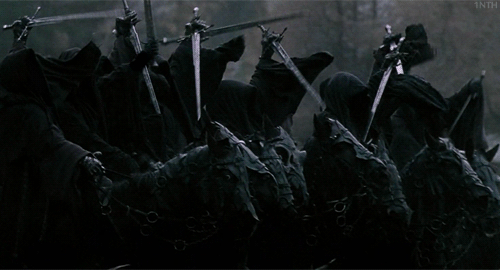
Throughout the rest of the Second Age, the Black Prince stayed in Mordorand served Sauron by coordinating the efforts of the other Ulairi (or Ringwraiths). These years comprised the period of his complete transformation into a hideous Wraith possessed of an exceptional command of sorcery. His role as the Lord of the Nazgûl testified to his awesome magical skills. Ironically, Mûrazôr was the only Ringwraith who had not presided over a kingdom of his own for a considerable period prior to accepting his Ring of Power; however, his origins as a Prince of the Edain of Númenor provided him with inherent abilities that far exceeded those of his undead peers.
Sauron gave the Black Prince all of the trappings of a King for, aside from Sauron himself, the Lord of Morgul was the mightiest servant of Darkness in Mordor’s hierarchy. No one, not even the warlord Gothmog (and, laterLieutenant of Morgul) or the Mouth of Sauron, enjoyed such trust from the Dark Lord. Their relationship flourished throughout the latter part of the Second Age, as teacher and pupil sought to build an unassailable kingdom and establish dominion over Men.
Unfortunately, the corruption of Númenor that they sought for so long produced a policy of imperialism. The goals of Númenor’s Kings came to mirror, at least in part, those of the Dark Lord. Both powers sought to unite the Secondborn under one absolute monarch. Inevitably, this rivalry between Sauron and the Black Prince’s brethren erupted into outright war.
Ar-Pharazon, the last Númenórean King and the strongest of Númenor's later Kings, led an armada to Middle-earth in S.A. 3261 in hopes of crushing the forces of Mordor and establishing hegemony over Middle-earth. Landing at Umbar, he marched northward across Near Harad (then contested by Númenor and Mordor’s client,Adunaphel the Nazgûl) and met the Host of Mordor near the river Harnen in early S.A. 3262. The Adan King’s army appeared too potent for Sauron to contest, so he surrendered and went to Númenor as Ar-Pharazon’s prized captive.
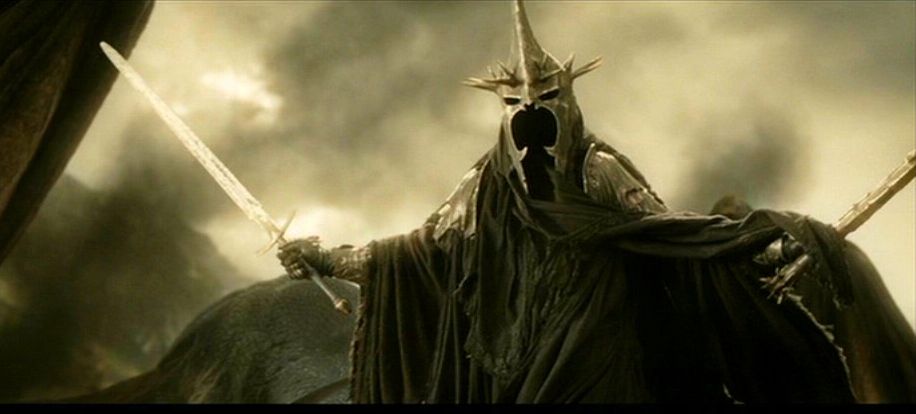
The capture of the Dark Lord left the Black Prince briefly in control of the Kingdom of the Shadow, but the omnipresence of the Edain forced the Ringwraith and Sauron’s other minions into hiding. This prevented the Lord of the Nazgûl from waging any significant campaigns in his Master’s absence. Although he and the other Ulairi contested Númenórean advances in certain regions of Middle-earth, the Black Prince operated very quietly until Sauron’s return after the Downfall of Númenor in S.A. 3319.
Sauron's reappearance in Mordor in S.A. 3320 sparked a renewal of the wars of conquest against the Free Peoples of Middle-earth and brought the Ringwraiths out of hiding. For the next 109 years, the forces of the Shadow regrouped, grew, and mobilized under the guidance of the Lord of the Nazgûl. Then, in S.A. 3429, the Black Prince led an army into Ithilien and assailed Gondor, the newly founded South Kingdom (which, like Arnorin the North, was one of the Kingdoms in Exile). King Anarion of Gondor (the co-ruler with his brother Isildur) successfully defended the west bank of the Anduin, dealing a stalwart blow to the Black Prince’s plan to subjugate the South Kingdom before the arrival of any Dunadan relief force from Arnor.
The ensuing standoff lasted five years, until the Black Prince was forced to retire toward Morannon in the face of an army from the North led by Gil-galad and Elendil the Tall. Joined by the Dark Lord’s main horde, the Black Prince turned on his pursuers in the fields of Dagorlad, before the Gates of Mordor. There, the Last Alliance of Men and Elves vanquished the Lord of the Nazgûl’s warriors and broke the defence of the Black Land. The victors chased the shattered remnants of Sauron’s army to Barad-dûr, and then they laid siege to it for seven years. Anarion died under a stone cast from the battlements in S.A. 3440, but his death was avenged the following year. The Last Alliance finally entered the hold of the Lord of the Rings in S.A. 3441, ending both war and the Second Age. Sauron slew both Gil-galad and Elendil, but King Isildur of Gondor cut the Dark Lord down and sliced the One Ring from his twisted hand. Thus, Sauron and his nine Ulair servants passed into the Shadows.
The Early Third Age
The Kingdoms in Exile enjoyed great prosperity during the first millenium of the Third Age, for it was not until T.A. 1000 that Sauron stirred again in Arda. Gondor conquered a vast realm, while Arnor established dominion over most of Eriador. Despite constant wars with Harad and the sundering of the North Kingdom in T.A. 861, theDunedain reached great heights of power.
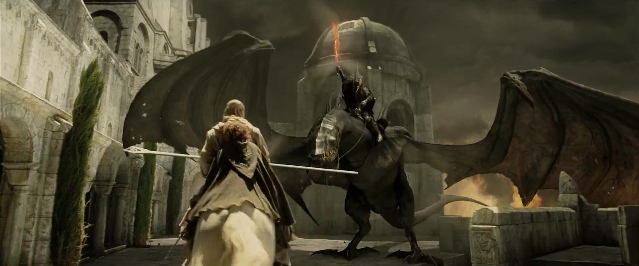
As Gondor reached the apogee of its might in T.A. 1050, however, the Nazgûl returned from the Shadows and began rebuilding their strength in Middle-earth. The Lord of the Nazgûl went to Dol Guldur in Rhovanion, where Sauron hid under the guise of the "Necromancer". He remained in the Dark Lord’s hold for the next two and a half centuries. From this secure refuge, he plotted the destruction of Arnor, the weaker of the two Dunadan kingdoms. The Lord of the Nazgûl understoon that care was in order, knowing that the loss of the One Ring at the end of the Second Age significantly weakened the forces of Darkness.
By T.A. 1300, the methodical plan to crush Arnor was complete, and the Lord of the Nazgûl flew north to the plateau that rises between the two northwestern spurs of the Misty Mountains (Hithaeglir). This cool, high plain overlooked the wilds along the northeastern frontier of the realm he planned to destroy. It was their that he founded his own kingdom: Angmar (Q. “Iron Home”), the land of the Witch-King.
The Rise of the Witch-King
The Lord of the Nazgûl ruled his new domain from the mountain citadel of Carn Dum (S. “Red Fort” or “Red Hold”), a giant cavern fortress built into and around the last peak in the northern Hithaeglir. Never revealing his true identity, he gathered two hosts: an army of over thirty Orc tribes commanded by the Olog warlord Rogrog; and the Angmarrim, a force of over 10,000 Men drawn from the Dark Lord’s subject peoples in Eriador, Rhovanion and Rhun. These warriors deployed in holds along the ridges north of the Ettenmoors and theOiolad (S. “Cool Plain”). Holds like Morkai and Mount Gram threatened all of the North Kingdom’s upper frontier, but they initially concentrated near the sparsely populated northeastern border – above the relatively vulnerable and rude realm of Rhudaur (S. “Troll Shaw”).
Arnor’s breakup on T.A. 861 left three ostensibly allied successor states: Arthedain in the northwest, Cardolanin the South and Rhudaur in the northeast. Both Arthedain and Rhudaur lay near Angmar, but the latter of the two northern realms was far weaker. Arthedain enjoyed a very large proportion of Dunadan residents and harbored both of Arnor’s capitals and most of the lost kingdom’s major castles. Rhudaur, on the other hand, contained relatively few of the Dunedain, and most of its often disgruntled population was scattered in the rugged countryside. It appeared to be a natural target for the Witch-King's hungry armies so, in the first five decades of Angmar’s rise, the Witch-King’s hordes overwhelmed the East Wood and brought its surviving population under the Shadow. Rhudaur ceased to exist as an independent and free nation by the middle of the fourteenth century, T.A., and thereafter acted as both a client state and buffer zone for Angmar.
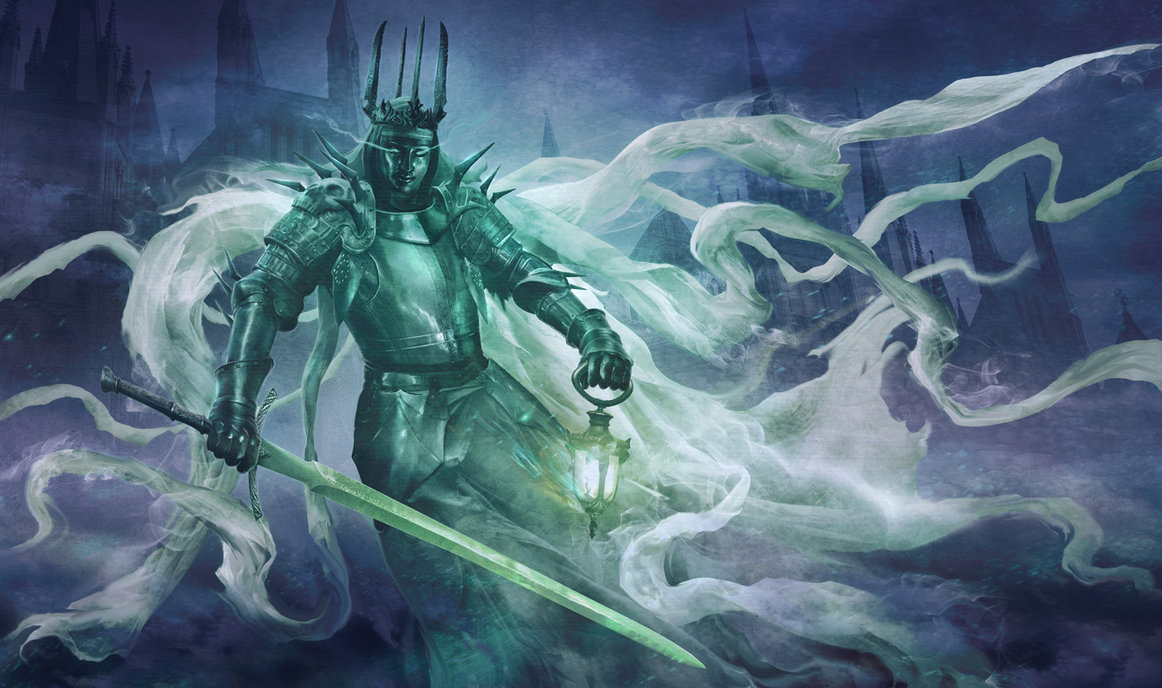
The conquest of Cardolan (S. “Land of Red Hills”) served as the Witch-King’s next goal. While much stronger than Rhudaur, it lacked Arthedain’s military resources and natural defences. Its capital and main city, Tharbad, sat on the lowlands along the river Gwathlo and much of its border with Rhudaur was composed of a sparsely defended hedge wall. Cardolan’s strategic value also invited attack, for Tharbad straddled the road between Arnor and Gondor, and the capture of this vital artery meant the isolation of Arthedain. Just as important, the Witch-King could virtually surround Arthedain’s heartland with the taking of its southern neighbor.
These factors led to the subsequent attack on Cardolan. Rhudaur declared war on the Land of Red Hillssometime before T.A. 1350, and fighting raged along the Mitheithel and near Amon Sul (Weathertop) for the next 59 years. With the help of the Arthadan army, the Dunadan Princes of Cardolan bested their old allies, however, and the Witch-King was eventually forced to commit his own troops. After building his supply routes through Rhudaur, the Witch-King ordered his forces to join the war and directly assault the dike and hedge wall that guarded Cardolan’s northeastern bounds. The Angmarrim crossed the open Lone Lands and smashed through the Dunadan defences south of Weathertop. Surrounding the great Arnorian citadel that housed one of the three Palantiri of the North, the host of Angmar cut the defending forces in half and drove the Prince and his retainers through the Barrow-downs (Tyrn Gorthad) and into the eaves of the Old Forest. The last ruler of Cardolan died as Tharbad fell.
Arthedain’s main army barely survived the battle that took place at Weathertop. Withdrawing into the surrounding hills with the Seeing-stone, they yielded the tower on Amon Sul and retreated home to Fornost. The Angmatrim razed the citadel after wiping out its few remaining defenders – brave fighters who fought to cover the retreat of their brethren. Once again, the Witch-King prevailed. Cardolan passed into his fold.
Arthedain survived 566 years after the collapse of its last sister state. Facing overwhelming odds, the Dunedain of the last successor kingdom doggedly drove off a number of major attacks along its eastern and northern boundaries. Many of Arthedain’s beleaguered people relocated toward the frontier and concentrated in Fornostor in manors and settlements near the kingdom’s border forts, enabling the Edain of the North to react to any significant incursions.(This shift invited the Hobbit migration into Arthedain’s Shire in T.A. 1600-40).
Nature intervened as well, for the buildup of Angmar’s forces in Cardolan prior to T.A. 1636 ended with the onset of the Great Plague. The pestilence that struck during the winter of 1636-37 devastated Cardolan’s remaining residents, but it also decimated the Witch-King's southern army. Angmarrim in Rhudaur and Angmar also fared poorly – much more so than the Dunedain – forcing the Witch-King to rebuild his shattered forces and delaying the final confrontation for another three centuries.
Arthedain’s end came in the War of T.A. 1973-75. After nearly a decade of massing on the Arnorian frontier, the Witch-King poised his armies for the killing blow and King Arvedui realized that the Host of Angmar could not be stopped without aid from Gondor. He urgently appealed to Earnil but, before the Gondorians arrived, the Witch-King initiated his felling strike. Angmar’s armies overran Arthedain in T.A. 1974, sending Arvedui into hiding in the abandoned Dwarf mines of the Nan-i-Naugrim in the Blue Mountains of Lindon. Arvedui died in the Ice Bay the following year while seeking aid from the Lossoth of the Far North. Both of the Palantiri his retainers had rescued during the slaughter in Arthedain perished with him. Their loss fittingly symbolised the end of the North Kingdom and the completion of the Witch-King's primary goal.
Although the Lord of the Nazgûl crushed Arnor, he faced a much greater foe. Gondor’s relief army landed as Arvedui fled northward and marched to challenge the victors. Meeting the Witch-King near the ruins of the ancient Arnorian capital of Annuminas, Earnur of Gondor and his Eiadorian allies vanquished the Host of Angmar and drove the Witch-King from the field. His Iron Home fell later the same year, ending the saga of theNorthern Wars.
Minas Morgûl - the City of Black Sorcery
Following the fall of Angmar, Sauron sent his exiled Lieutenant to join his eight companions in Mordor. There, the Witch-King gathered the Ulairi and planned the surprise attack against Minas Ithil, the Gondorian capital of Ithilien and the key to the valuable cleft of Cirith Ungol (S. “Spider Pass”). The Ringwraiths quietly assembled an army in Gorgoroth and unleashed its fury in T.A. 2000. Quickly surrounding their prize, they cut the town off from the rest of Gondor and settled into a two-year siege.
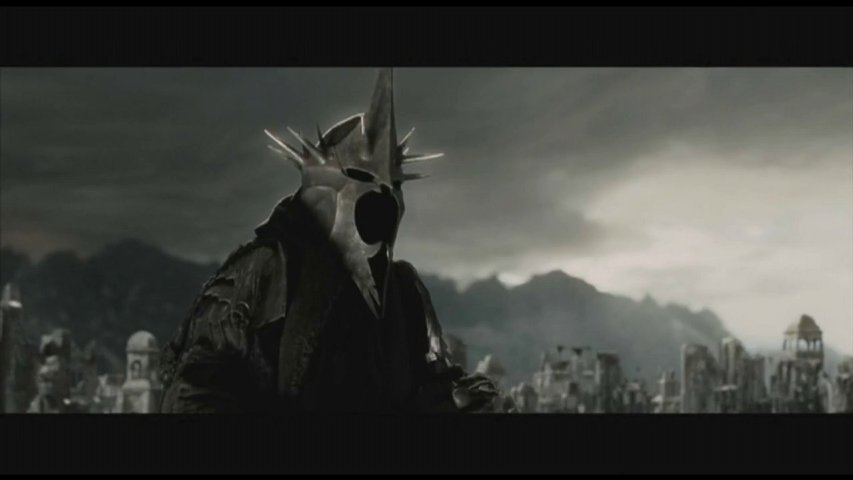
In T.A. 2002, the Witch-King entered Minas Ithil and made the white marble city his new home. It remained his abode until his death. The Men of Gondor mourned the loss, renaming the Tower of the Moon Minas Morgul – the “Tower of Dark Sorcery.” From that point onward, the glow of the town’s moonlit walls signified Evil and shone like a symbol of the Witch-King’s terror.
The Palantir housed in Minas Morgul’s Tower of the Stone served Sauron well throughout the next millennium. It’s presence, coupled with the strategic and emotional value of the city itself, compelled the Dunedain of the Gondor to try to recover the fortress town. Ever deadly and always wily, the Morgul-lord played upon their desires and desperation, twice challenging Gondor’s champions to single combat. The Witch-King slew PrinceEardur of Lond Ernil (Dol Amroth) – the last of the First Line of Princes in Dor-en-Ernil – in T.A. 2004 and he cut down King Earnur in a duel in T.A. 2050, ending Gondor’s Line of Kings. Both times the Dunadan challenger died before the silvery gates of the city. Earnur’s death marked the beginning of the era of Ruling Stewards and signified and end of any pretense surrounding the recapture of Minas Morgul and the western pass into Mordor.
The Prelude of the War of the Ring
The Witch-King oversaw Mordor for the next 891 years, until the return of Sauron from Dol Guldur in T.A. 2941. His minions multiplied, fortifying the Morgul Vale around the mouth of Cirith Ungol. Minas Morgul became a nearly impenetrable bastion haunted by the shrieks of the resident Ringwraiths. All the while, the Dark Lord’s Black Captain prepared for the coming war and guarded his Master’s homeland.

The Witch-King only launched one attack into the neighboring province of Ithilien during this respite, an Urukattack against the exposed and underpopulated city of Osgiliath (S. “Fortress of the Stars”) on the Anduin. The former capital of Gondor sat astride the best route across the lower part of the Great River, and its huge stone bridge loomed as the most convenient route to Minas Tirith. In T.A. 2475, the Uruk-hai swept out of Minas Morgul and drove through the old city under the cover of a befouled night sky. Although retaken by the Dunedain, Osgiliath’s bridge – and the lofty Tower of the Stone that held the Master Palantir and rose above the centre of the river – fell into the Anduin. The Fortress of the Stars became a deserted and ever threatened stronghold as the rest of Ithilien came under the Shadow.
Work began on Barad-dûr in T.A. 2951, ten years after the Dark Lord’s arrival in Mordor, and the minions of Darkness gathered in Gorgoroth and Minas Morgul for the next and ultimate assault on Gondor. Sauron was desperate in light of the possibility that the lost Ruling Ring would fall into the hands of a worthy foe. He resolved to destroy the Free Peoples before they could gather under the banner of another King. The preparations lasted 67 years, so it was not until T.A. 3018 that the Host of Mordor and the Lord of the Rings stood poised for the Great War.
The Search for the Ring
With the end of winter, the Witch-King led Sauron’s southern army against the garrison at Osgiliath, throwing the Gondorians across the river. The Black Captain’s forces pursued the defenders onto the western bank and through the west quarters, securing the city for the Dark Lord’s coming invasion. Gondor’s army reacted with greater strength than anticipated, however, and the southern horde progressed no further. As the lines stabilized, the first test of the Free Peoples ended with the Witch-King’s departure on the quest for the One Ring.
As Chieftain of the Black Riders, he rode with the other eight Ulairi up the Anduin Valley in search of the Shire. Reaching the old Stoor homes at the Gladden Fields (where Deagol and Smeagol found the Ruling Ring), they routed the few residents and uncovered nothing of any import. Sauron’s Lieutenant realised that they had mistaken the ancient settlement for the real land called Suza (Kd. “Shire”), so he ordered his companions to turn south and head for Eriador. They skirted between Lorien and the cliffs to the west and rode through Rohanand past Isengard into Eriador. Taking the Greenway to Tharbad, the Nine crossed the Gwathlo and entered old Cardolan. Eventually they split into two groups, with Khamul leading two Riders through the Shire while the Witch-King took the others north toward Andrath and Bree in hope of cutting off any support or opportunity for flight.
After failing to capture their prey, the Nazgûl gave chase along the Great East Road. Uvatha the Messengerbroke off to deliver word to Khamul of the Hobbits’ escape route. The Witch-King and his four other companions rode toward the commanding summit of Weathertop, where the view of the road and the neighboring expanse ofDyr Erib (S. “The Lone Lands”) offered a means of insuring that they could intercept the fleeing Halflings. Seeing firelight on the peak, the five Ringwraiths followed the most recent tracks up the hill and attacked the resting Company in hope of attaining their Master’s prize. Three Nazgûl advanced as the Hobbits formed a tight circle around the fire. The Witch-King stabbed Frodo in the left shoulder with his Morgul-knife as Aragorn leaped to intercede. Luckily, the firebrand and Aragorn’s bravery enabled the Hobbits to survive the nocturnal visit, as the five Ulairi retired.
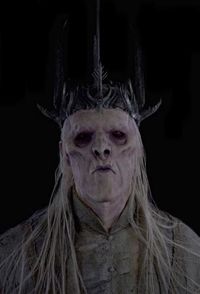
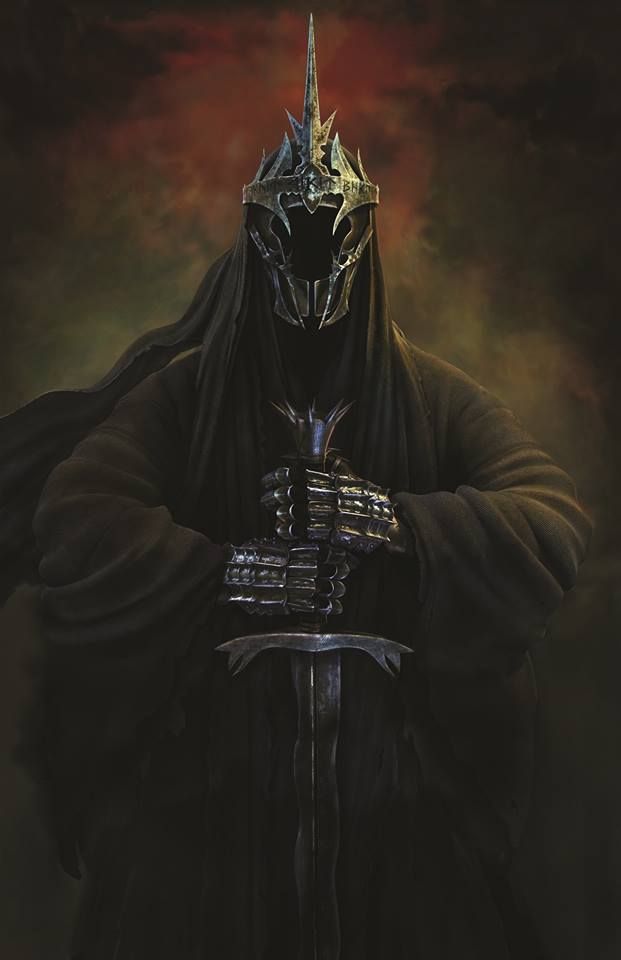
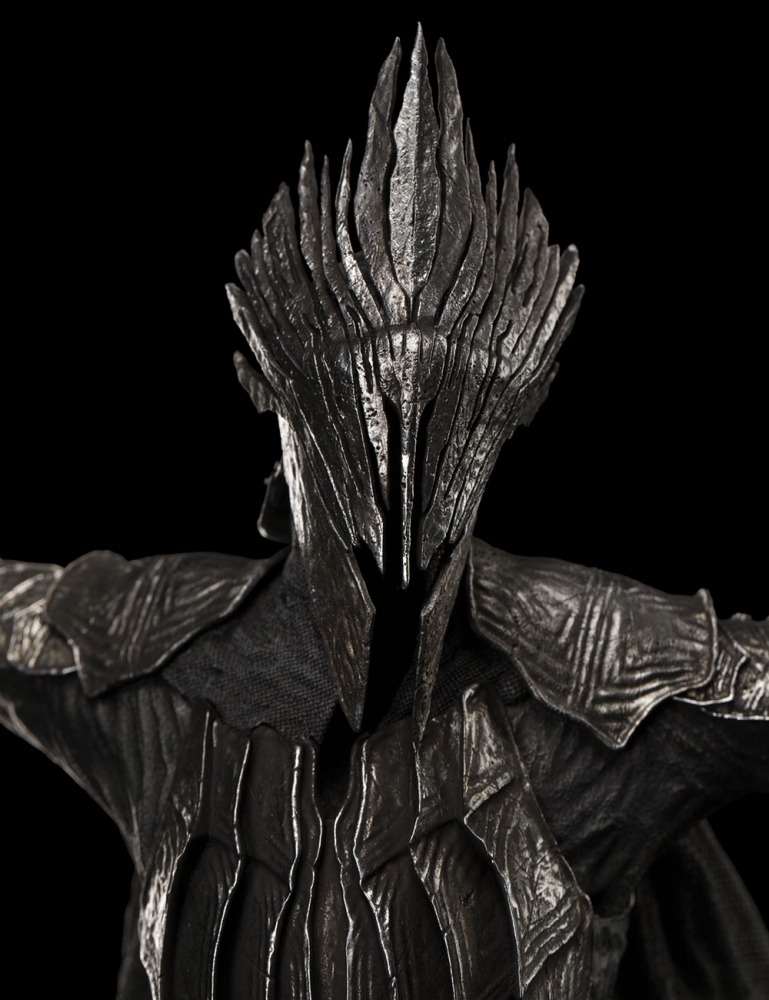
Frodo’s wound proved unmendable without aid from a high Healer, for the Black Captain’s blade imbedded itself and slowly worked its way toward the Hobbit’s heart. Although unsuccessful in the melee on Amon Sul, the Witch-King’s cursed weapon placed Frodo in grave danger of becoming a Wraith and falling under the Ulair’s spell. Strider realized the Halfling’s plight after finding the knife hilt and prepared an Athelas wash, but he knew that the party had little time to spare. With daylight, the Company fled toward the Bruinen Ford.
The Witch-King watched and, after joining with Khamul’s Riders, he and the other Nazgûl broke into furious pursuit. The Nine rode their prey down at the Bruinen Ford just west of Rivendell and cried for Frodo to surrender. As the Hobbit balked and summoned his last strength to finish the crossing, the Witch-King plunged into the river with two of his servants (Uvatha and Dwar) – only to find themselves engulfed beneath a torrential tide of magically summoned floodwaters. The enchanted current swept the Morgul-lord and the other eight of the Black Riders downstream, claiming their awful steeds. So ended the search for the Ring.
The War of the Ring
After the disaster at the Bruinen Ford, the Witch-King retired to Minas Morgul and returned to his role as commander of Mordor’s southern host. His goal was Minas Tirith and the defeat of Gondor. For this purpose, he arrayed his main army outside Osgiliath, planning a pincer of two wings. The other force issued out ofMorannon and massed upriver by Cair Andros, providing the Ringwraith with a pair of Anduin crossings and insuring that his enemies could not flee northward into Rohan.
The Gondorians retook western Osgiliath in early T.A. 3019, but soon thereafter the Black Captain sent his army across the river and scattered the guards in the ruined city. As the Morgul-host drove across the river from the east, smashing through the gates of the Rammas Echor that enclosed the Pelennor (S. “Fenced land”), another army came south from Cair Andros and entered the encircling outer walls from the north. The retreating defenders reached the city gates as the two attacking arms joined. Minas Tirith was surrounded.
The battle that followed took place before the walls of the city. As the ram Grond smashed the Great Gates, the main Hafhere of 6,000 Riders and the 120 Rohirrim of Theoden’s Guard struck the attacking force from the north, sending waves of Orcs into retreat. The Hafhere, led by Eomer, overran the main road and rode into the Haradrim between the ramparts and the river while Theoden and his guard skirmished with the Haradan Lord in front of the Great Gates. For the first time, the tide of battle favored the Free Peoples, and Prince Imrahil of Dol Amroth gathered the warriors in the forecourt of the city in preparation for a sally into Pelennor.
The Final Death of the Witch-King
The Lord of the Nazgûl responded by personally intervening in the fray involving the Rohirric King. Flying on the back of his Fell Beast, he dove upon Theoden. The advancing Rohirrim’s horses panicked as the Witch-King slew the Lord of Rohan with his awful mace. This act reversed the Ringwraiths' fortunes and endangered the Rohirric army; but, more importantly, it enraged Theoden’s niece Eowyn, who fought disguised as the youthDernhelm.
Fully armored and unrecognizable as a woman, Eowyn challenged the Witch-King as he stood over the bodies of her uncle and his beloved mount Snowmane, but the Morgul-lord scoffed at her words. Proclaiming that no man was fated to slay him, the Lord of the Nazgûl savored his kill and warned her of her folly, not knowing that he faced a maiden. It was then that Eowyn shed her helm and announced:
“Butno living man am I! You look upon a woman. Eowyn I am, Eomund’s daughter. You stand between me and my lord and kin. Begone, if you are not deathless! For living or dark undead, I will smite you if you touch him.”
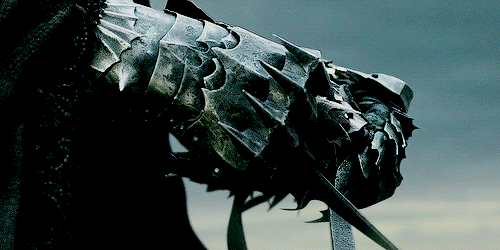
Silent, the Witch-King rose on the sweeping wings of his Fell Creature, his fear and ire aroused. Eowyn stood strong, though, as the evil beast descended to attack her with its hideous claws and beak. She parried the initial foray and then sliced the monster’s head from its long neck. The Fell Beast tumbled to the ground, but the Lord of the Nazgûl rose again and advanced with his mace held high. He struck her green shield, shattering it, and raised his weapon for the slaying blow. Suddenly, the Hobbit Merry rushed behind him and plunged his enchanted sword into the back of the Witch-King’s knee, breaking the spell that held the Morgul-lord’s immortal form together, and giving Eowyn time to recover. The Rohirric maiden gathered herself and drove the blade through the Ringwraith’s neck. As fated, no man slew Sauron’s Lieutenant; instead, he perished at Pelennor by the hand of a woman, and an ancient sword wielded by a Halfling. The Lord of the Nazgûl finally passed out of Ea.

Silvan Elves (also known as Woodland Elves) are described as being less interested in knowledge seeking than other Eldar, like the Noldor. Some of them are mistaken for Avari, those who never joined the Great Journey fromCuiviénen to Aman.
The Silvan elves were notably of Nandorin background and descended from the followers of Lenwë who were fascinated by the landscape and its features of the lands East of the Misty Mountains, and followed the Great River down into south and beyond. Many centuries later, they reappeared and spread themselves throughout the regions between the Misty Mountains and the Blue Mountains. Later yet, they appeared in the Beleriand under the leadership of their only king Denethor and were allied to Thingol, the elven King of Doriath. When Morgoth attacked Beleriand, Denethor was killed and his people suffered heavy causalities and later became a secretive people throughout the rest of the First Age.
When the Beleriand was lost and the Second Age was to begin, the Silvan elves who survived rejoined their kindred east of the Misty Mountains and gradually became citizens of the Elven realms of Lórien and Greenwood the Great (laternorthern Mirkwood), or were at times wanderers.
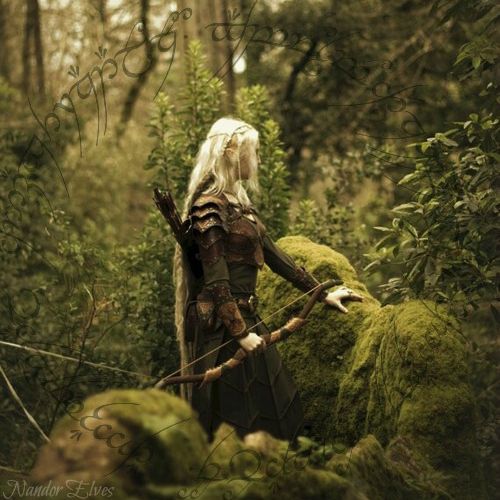
According to notes made by Tolkien after the publication of Lord of the Rings and found in Unfinished Tales, Oropher, the Sindarin king of the Silvan Elves of Mirkwood, orGreenwood the Great as it was then known, raised a large force as part of the Last Alliance to overthrow Sauron. During the first assault on Mordor, he disregarded Gil-galad's tactical plan and led a reckless charge in which he was slain along with two-thirds of his troops. Rule of the Silvan Elves and field command of their remaining strength passed to Oropher's son Thranduil, the father of Legolas.
The Silvan Elves of Mirkwood are described as distrustful of Dwarves, but friendly to Men, with whom they trade. In The Hobbit, Bilbo Baggins has to rescue the Dwarves of Thorin's company from these Elves. Later in the book the Elves are one of the armies in the Battle of Five Armies.
Legolas of the Fellowship of the Ring, although he lived among them and presented himself as one of the Silvan folk in The Lord of the Rings, was not one of them. As a son of the Elven-king Thranduil, who had originally come from Doriath, Legolas was actually a Sindarin Elf.
In the 1977 animated adaption of The Hobbit, The Wood Elves are depicted as having fair hair and pale lavender skin, with clothing predominantly brown and olive coloured garb.
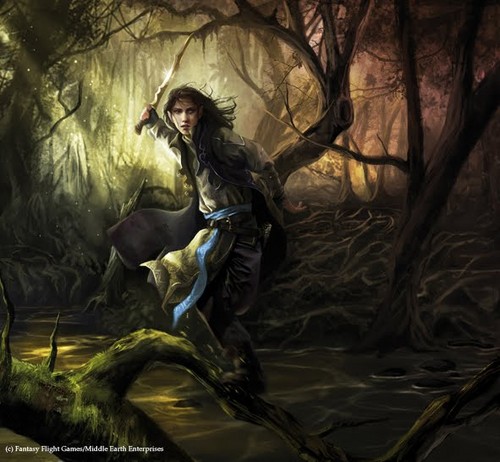
The Silvan Elves of Lórien are also called the Galadhrim, literally "tree-folk". After the departure of Amroth in T.A. 1981, they were ruled by Celeborn and Galadriel. At the time of the War of the Ring they spoke a divergent dialect of Sindarin which had changed so much that Frodo Baggins, who spoke some Sindarin, could not understand them. Additionally, few Elves of Lórien could speak Westron, so that Haldir, one of the few who could, had to accompany them on their way to Caras Galadhon. During the War of the Ring the Galadhrim were the strongest of all the Elven kingdoms and aided in banishing Sauron the Necromancer from Dol Guldur.
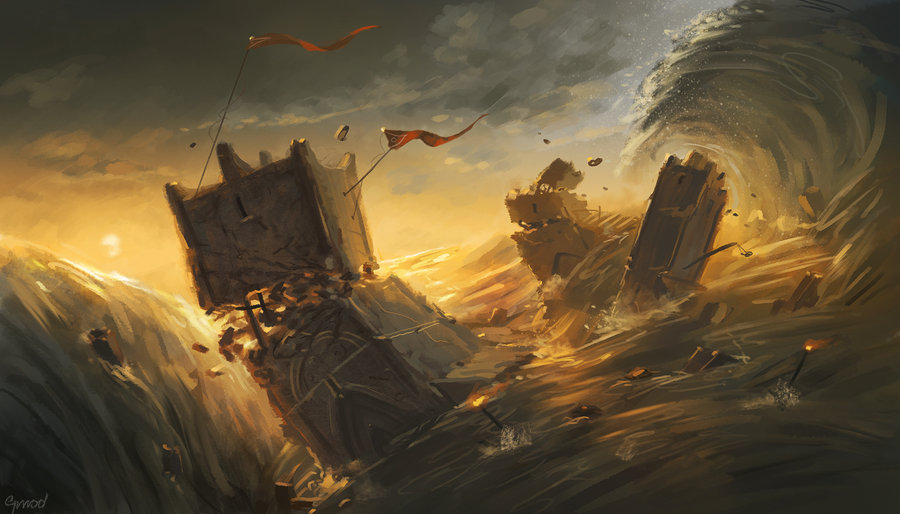
During the Second Age, Sauron, Morgoth's greatest servant, had grown mighty in Middle-earth. Defeating all resistance and ruling through terror, force, and persuasion, Sauron dominated the peoples of Middle-earth, who looked to Númenor for aid. Heeding their desperate plight, the Númenorians dispatched an immense military force to Middle-earth, and after a period of heavy fighting, defeated Sauron and his hosts. Sauron hid within Mordor, where none dared to assail him, and re-built his strength. After once more reaching a height in his power, and with the armies of Númenor having left Middle-earth, Sauron was for a second time unopposed, and took on the titles Lord of the Earth and King of Men.
The Númenorians again received word of his rise in power. Angered by Sauron's pride and wishing to avoid another difficult war, the Númenorians swiftly came once more to Middle-earth with immense military force to confront Sauron a final time. So mighty were they that Sauron's forces fled from them with barely a fight. Sauron, however, realizing he could not defeat the Númenorians militarily, allowed himself to be captured, and begged, falsely, for mercy. The Númenorians brought him back as a prisoner, though through Sauron's persuasion, he rose from prisoner to advisor for the King himself. Convincing many officials to worship Morgoth, they quickly became corrupted to his side, to the point where Sauron successfully convinced King Ar-Pharazôn to betray the Valar and besiege them.
Elendil, son of the leader of the Faithful during the reign of Ar-Pharazôn, his sons and his followers had foreseen the disaster that was to befall Númenor, and they had set sail in nine ships before the island fell. His father Amandil the Lord of Andúnië, imitating Eärendil, decided to go West to warn the Valar about the King's plans.

Flooding of Númenor
Prompted by Sauron and fearing death and old age, Ar-Pharazôn built a great armada and set sail into the west to make war upon the Valar and seize the Undying Lands. Sauron remained behind. In the year 3319, Ar-Pharazôn and his Great Armament landed on Aman's shores and marched to the city of Valimar.
The Valar feared that the Númenorean army could wrack havoc in Valinor, but they were forbidden from killing or otherwise using force against Men. Manwë, chief of the Valar, thus called upon Ilúvatar, who destroyed the Great Armament of Ar-Pharazôn that had landed on Aman by crushing it under stones. He also broke and changed the world, taking Aman and Tol Eressëa from the world forever, changing Arda's shape from flat to round so that no sailor would seek the True West again. Númenor was covered by great waves and sank into the abyss, killing its inhabitants, including the body of Sauron; Sauron was robbed of his ability to assume fair and charming forms.
New lands formed in the West to replace the absence of Aman; islands rose and hills were formed. The coastline of Middle-earth also felt the effects of the cataclysm. In some places the coasts retreated, and in others they had advanced. Lindon in particular suffered great loss from the advance of the coasts, whereas the coasts had retreated to the east and south of the Bay of Belfalas, putting Pelargir much further inland than it had been and nearly destroying Tolfalas. As the Anduin found new courses along the new coasts, the Ethir Anduin formed.
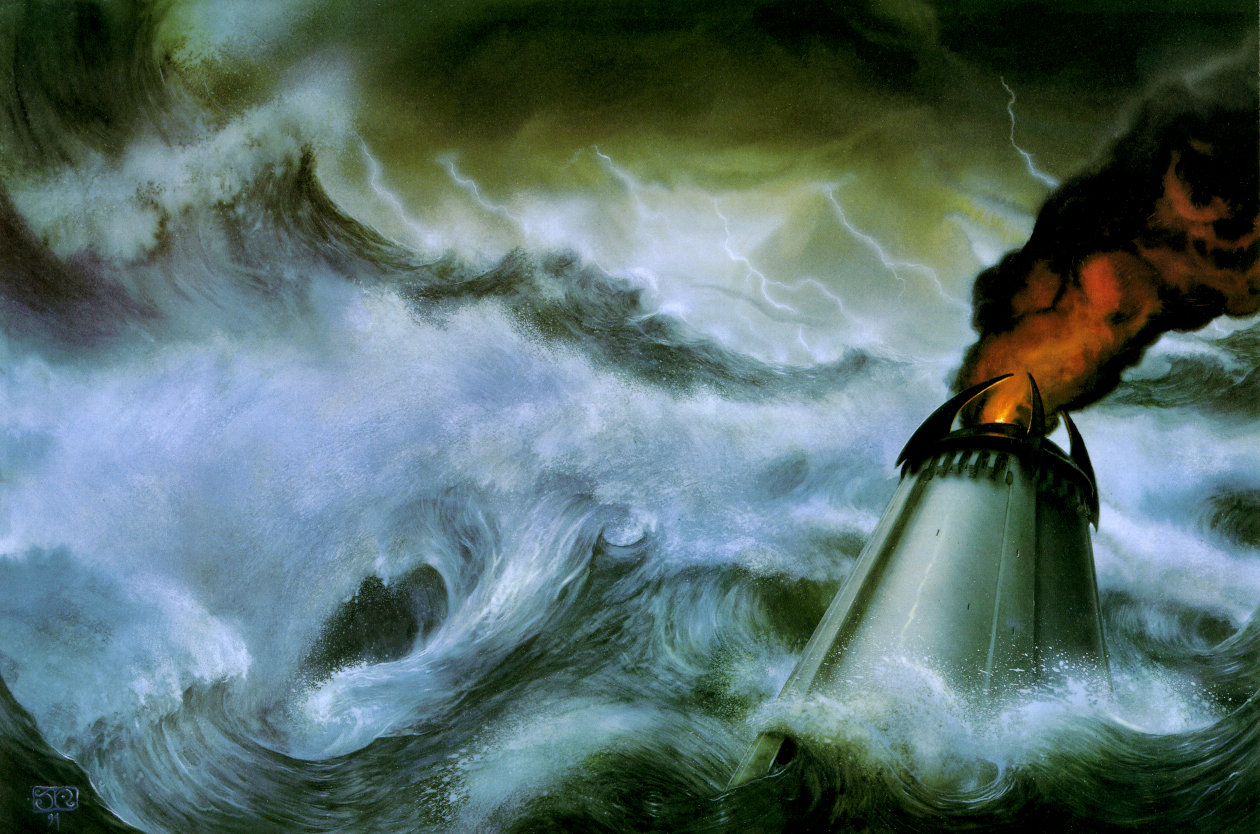
Survival
Just a few people, the Faithful, still uncorrupted by Sauron managed to escape the catastrophe; they fled Númenor by ship, carrying some gifts that the Dúnedain had received from the Valar and the Elves in times of peace. These were the Palantíri, the Ring of Barahir, the Sceptre of Annúminas, Narsil and a fruit of Nimloth the Fair stolen by Isildur. They were led by Elendil the Tall and his two sons, Isildur and Anárion.
They landed in Middle-earth and met the colonists who were in the settlements of those lands among the Middle Men; the followers of Elendil united them by establishing two kingdoms which came to be known as as the realms of Exile: Gondor in the south, and Arnor in the north. The culture of Númenor became the dominant culture of Middle-earth (thus, Westron, a descendant of the Adûnaic language of Númenor, became the Common Speech). The sadness and the shock from the loss of their island home always remained in the hearts of Kings of Númenórean descent.
They were dismayed to discover that Sauron, although greatly diminished and bereft of shape, had survived the Downfall and returned to Middle-earth with the One Ring to continue troubling its inhabitants.
Meanwhile some of the King's Men had established other realms in exile to the south; of these the Haven of Umbar was the chief and continued to reign the lands there. These were known as Black Númenóreans.
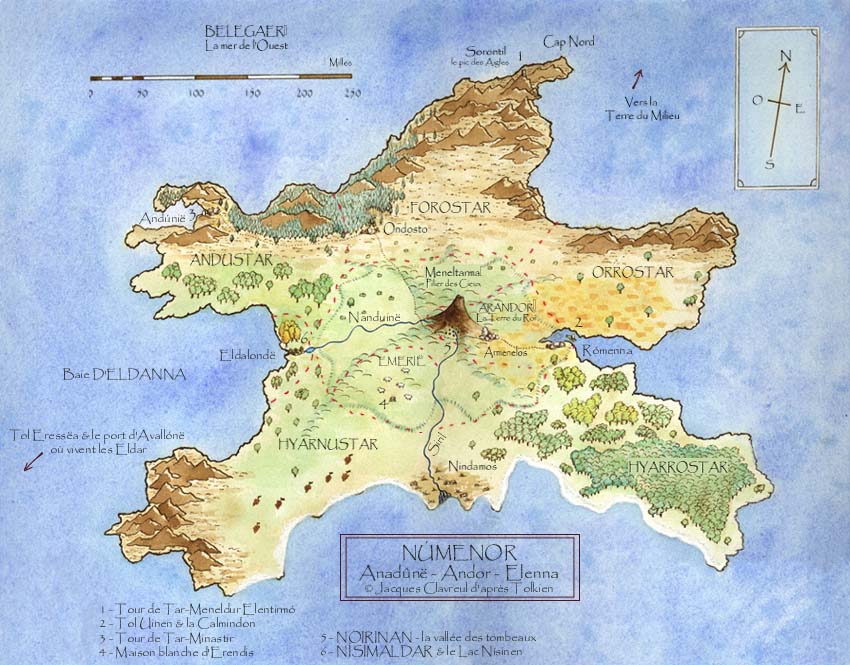
HISTORY OF QUENYA
Quenya or High-elven is the most prominent language of the Amanya branch of the Elvish language family. In Aman there were two dialects of Quenya, Vanyarin and Noldorin. For historical reasons, only the latter was used in Middle-earth. The only other Eldarin language spoken in Aman, Telerin, could also be considered a dialect of Quenya, but it was usually held to be a separate language and is not discussed here (see separate article).
Compared to many other Elvish tongues, Quenya was archaic. It preserved the main features of the original Elvish language, invented by the Elves when they first awoke by the mere of Cuiviénen - a tongue with "many...beautiful words, and many cunning artifices of speech" (WJ:422). In fact, the Silmarillion Index refers to Quenya as "the ancient tongue, common to all Elves, in the form it took in Valinor" in Aman - as if Quenya was so similar to Primitive Elvish that it was merely as a later form of it, not a new language. Indeed Primitive Elvish and Quenya may have been mutually intelligible, but it must not be thought that they were almost identical. In Valinor, the ancient Elvish tongue underwent certain changes: "Its altering ...[came] in the making of new words (for things old and new) and in the softening and harmonizing of the sounds and patterns of the Quendian tongue to forms that seemed to the Noldor more beautiful" (WJ:20). The sounds b and d became v and l (or n) initially, final long vowels were shortened, unstressed medial vowels often disappeared, and many consonant clusters underwent metathesis or other changes, generally making them easier to pronounce. Quenya also adopted and adapted a few words from the language of the rulers of Aman - the Valar, the Angelic Powers guarding the world on behalf of its Creator. However, the Valar themselves encouraged the Elves to "make new words of their own style, or...translate the meaning of names into fair Eldarin forms" instead of retaining or adapting Valarin words (WJ:405). It is stated that the Noldor "were changeful in speech, for they had great love of words, and sought ever to find names more fit for all things that they knew or imagined" (Silm. ch. 5).

In Aman, Quenya was spoken not only by the Vanyar and the Noldor, but also by the Valar: "The Valar appear quickly to have adopted Quenya" after the arrival of the Elves, and their own tongue, Valarin, was not often heard by the Eldar: "Indeed it is said that often the Valar and Maiar might be heard speaking Quenya among themselves" (WJ:305). Pengolodh the sage of Gondolin notes: "In the histories the Valar are always presented as speaking Quenya in all circumstances. But this cannot proceed from translation by the Eldar, few of which knew Valarin. The translation must have been made by the Valar or Maiar themselves. Indeed those histories or legends that deal with times before the awakening of the Quendi, or with the uttermost past, or with things that the Eldar could not have known, must have been presented from the first in Quenya by the Valar or the Maiar when they instructed the Eldar." He mentions the Ainulindalë as an example: "It must...have been from the first presented to us not only in the words of Quenya, but also according to our modes of thought." Indeed even Melkor learnt Quenya, and learnt it well. "Alas," Pengolodh notes, "in Valinor Melkor used the Quenya with such mastery that all the Eldar were amazed, for his use could not be bettered, scarce equalled even, by the poets and the loremasters." (VT39:27)
When Rúmil invented letters, Quenya became the first language to be recorded in writing (Silm. ch. 6, LotR Appendix F). But outside the Blessed Realm of Aman, Quenya would never have been known if it had not been for the rebellion of the Noldor in the First Age. Most of this clan left Aman and went into exile in Middle-earth, bringing the High-elven tongue with them. In Middle-earth the Noldor were greatly outnumbered by the native Sindar or Grey-elves, who spoke a clearly related, yet quite different language. The Sindarin tongue had long since dropped the case inflections that were still preserved in Quenya, and the general sound of the two languages differed much - Quenya was much more vocalic than Sindarin and had a very limited distribution of the voiced stops b, d, g, that were frequent in Sindarin. As it turned out, "the Noldor...learned swiftly the speech of Beleriand [i.e. Sindarin], whereas the Sindar were slow to master the tongue of Valinor [i.e. Quenya]". Twenty years after the coming of the Noldor to Middle-earth, "the tongue of the Grey-elves was most spoken even by the Noldor" (Silm. ch. 13). When King Thingol of Doriath finally learnt that the Noldor had killed many of his kinsfolk among the Teleri and stolen their ships when they left Valinor, he banned the use of Quenya throughout his realm. Consequently, "the Exiles took the Sindarin tongue in all their daily uses, and the High Speech of the West was spoken only by the lords of the Noldor among themselves. Yet that speech lived ever as a language of lore, wherever any of that people dwelt" (Silm. ch. 15).
Thus Quenya did survive, even in the dark First Age. In fact, the vocabulary was expanded: The Noldor adopted and adapted some words from other tongues, such as Casar "dwarf" from Dwarvish Khazad and certa "rune" from Sindarin certh (WJ:388, 396). Some words already in use developed new or modified meanings in Exilic Quenya, such as urco, a word that in Valinorean Quenya was used of "anything that caused fear to the Elves, any dubious shape or shadow, or prowling creature" that was remembered in ancient tales of the March from Cuiviénen. In Exilic Quenya, however, urco was recognized as a cognate of Sindarin orch and was used to translate it; hence the meaning of urco was now simply "Orc" (WJ:390; the Sindarin-influenced form orco was also used). When the Edain arrived in Beleriand, they learned not only Sindarin, but "to a certain extent Quenya also" (WJ:410). Though Quenya "was never a spoken language among Men" (Plotz Letter), High-elven names like Elendil became popular among the Edain. Túrin gave himself the Quenya name Turambar or "Master of Doom", and his sister Nienor cried some High-elven words before she killed herself (Silm. ch. 21).

There are also numerous examples of Quenya being used or remembered by the Noldorin Exiles themselves: When Turgon built his hidden city, "he appointed its name to be Ondolindë in the speech of the Elves of Valinor", though the Sindarin-adapted form Gondolin became the usual name of the city. Even in Gondolin, Quenya "had become a language of books" for most people, "and as the other Noldor they used Sindarin in daily speech". Nonetheless, Tuor heard the Guard of Gondolin speak "in the High Speech of the Noldor, which he knew not". It is also stated that "Quenya was in daily use in Turgon's house, and was the childhood speech of Eärendil" (UT:44, 55). PM:348 confirms that "Turgon after his foundation of the secret city of Gondolin had re-established Quenya as the daily speech of his household". Aredhel left Gondolin and was captured by Eöl, to whom she bore a son, and "in her heart she gave him a name in the forbidden tongue of the Noldor, Lómion, that signifies Child of the Twilight" (Silm ch. 16). Eöl later called his son by the Sindarin name Maeglin, but Aredhel "taught Maeglin the Quenya tongue, though Eöl had forbidden it" (WJ:337).
However, Quenya as spoken by the Exiles early underwent some minor changes, probably before Thingol's edict against its use largely froze all processes of linguistic change. In a letter to Dick Plotz, Tolkien described the noun declension of an old form of Quenya, so-called "Book Quenya". Tolkien writes that "as far as was known to [mortal] men - to the Númenorean scholars, and such of these as survived in Gondor in [the Third Age] - these were the forms used in writing". But he further notes: "Quenya as a spoken language had changed to a certain extent among the Noldor before it ceased to be a birth tongue [i.e. early in their exile]... In this 'colloquial' form it continued to be spoken among Elves of Noldorin origin, but was preserved from further change since it was learned anew from writing by each generation." The implication seems to be that also this "colloquial" form of Quenya could be used in writing, and that this was the Quenya of the writings from which each generation learned the language anew. These would be writings written by the Noldor during their exile, after their language had diverged slightly from Amanian Quenya (in particular by the loss of the accusative case): "Exilic conditions...made necessary the writing down anew from memory of many of the pre-Exilic works of lore and song" (PM:332). The Númenorean scholars may have picked up a more archaic form of Quenya because they were in contact with the Eldar of Eressëa and Valinor, not only the Noldorin Exiles in Middle-earth. Today, most writers do not use Book Quenya, but the Exilic Noldorin form of High-Elven, the language of Galadriel's Lament (LotR1/II ch. 8).
The First Age ended in the War of Wrath. At the beginning of the Second Age, some of the Noldor returned to Aman, "but some lingered many an age in Middle-earth" (Silm. ch. 24). Thus, native speakers of Quenya were still present in the Hither Lands. Indeed even their greatest enemy made a Quenya name for himself when he appeared to the Elves in a fair form to deceive them: Annatar, the Lord of Gifts (Of the Rings of Power in Silm). His real name was also Quenya, but one may well understand that he did not like it: Sauron, the Abhorred (see Silm. Index). Later, the Smiths of Eregion gave Quenya names to their greatest works: Narya, Nenya, and Vilya, the greatest of the Rings of Power save the One Ring itself.
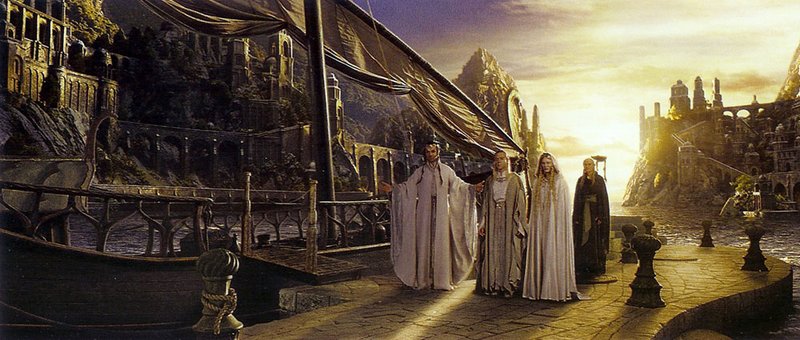
However, the history of the Second Age is dominated by the saga of Númenor, the great isle given to the Edain by the Valar. Originally all the Edain were Elf-friends, and most of them knew Sindarin (though the daily speech of the Númenóreans was Adûnaic, a Mannish tongue). We are told that "the lore-masters among them learned also the High Eldarin tongue of the Blessed Realm, in which much story and song was preserved from the beginning of the world... So it came to pass that, beside their own names, all the lords of the Númenóreans had also Eldarin [Quenya and/or Sindarin] names; and the like with the cities and fair places that they founded in Númenor and on the shores of the Hither Lands" (Akallabêth). Examples of Quenya names in Númenor include Meneltarma, Armenelos, Rómenna and the name Númenor itself. Yet the fact remained that "Quenya was not a spoken tongue in Númenor. It was known only to the learned and to the families of high descent, to whom it was taught in their early youth. It was used in official documents intended for preservation, such as the Laws, and the Scroll and the Annals of the Kings..., and often in more recondite works of lore. It was also largely used in nomenclature: the official names of all places, regions, and geographical features in the land were of Quenya form (though they usually had also local names, generally of the same meaning, in either Sindarin or Adúnaic [Númenorean]. The personal names, and especially the official and public names, of all members of the royal house, and of the Line of Elros in general, were given in Quenya form" (UT:216). The Kings took Quenya names because High-Elven was "the noblest tongue in the world" (UT:218). However, times would change.
The Númenoreans began to envy the immortality of the Elves, and the friendship with Aman gradually became cold. When the twentieth King of Númenor ascended the throne in the year 2899 of the Second Age, he broke with the ancient custom and took the sceptre with a title in Adûnaic instead of Quenya: Ar-Adûnakhôr, Lord of the West. In his reign "the Elven-tongues were no longer used, nor permitted to be taught, but were maintained in secret by the Faithful; and the ships from Eressëa came seldom and secretly to the west shores of Númenor thereafter" (UT:222). In 3102 Ar-Gimilzôr became the twenty-third King, and "he forbade utterly the use of the Eldarin tongues, and would not permit any of the Eldar to come to the land, and punished those that welcomed them" (UT:223). Indeed "the Elvish tongues were proscribed by the rebel Kings, and Adûnaic alone was permitted to be used, and many of the ancient books in Quenya or in Sindarin were destroyed" (PM:315).
However, Gimilzôr's son Inziladûn proved to be of a very different character when he became King in 3177 (or 3175 according to one source - see UT:227). He repented of the ways of the Kings before him and took a title in Quenya according to the ancient custom: Tar-Palantir, the Far-Sighted. Tar-Palantir "would fain have returned to the friendship of the Eldar and the Lords of the West", but it was too late (UT:223). His only child, a daughter, he named Míriel in Quenya. She should have been Ruling Queen after his death in 3255, but she was forced to marry Pharazôn, son of Tar-Palantir's brother Gimilkhâd. Pharazôn took her to wife against her will to usurp the sceptre of Númenor. Evidently he could not stand her Quenya name and changed it to Zimraphel in Adûnaic. Proud and arrogant, Ar-Pharazôn challenged Sauron in Middle-earth. The evil Maia cunningly pretended to surrender, whereupon Pharazôn "in the folly of his pride carried him back as a prisoner to Númenor. It was not long before he had bewitched the King and was master of his counsel; and soon he had turned the heart of all the Númenoreans, except the remnant of the Faithful, back towards the darkness" (LotR Appendix A). Sauron made the King believe that he would become immortal if he managed to wrest the rulership of Aman from the Valar, and eventually Pharazôn did attempt to invade the Blessed Realm. As Sauron well knew, the Númenoreans could never conquer the Powers, and as he had foreseen, Pharazôn's armada was utterly defeated. However, Sauron had not foreseen that the Valar would call upon the One Himself, and that He would use His power to change the entire shape of the world. The Blessed Realm was removed from the visible world into the realm of hidden things, and with it went all native speakers of Quenya save those of the Noldor who lingered in Middle-earth. Númenor itself disappeared in the sea, and we shall never know the number of the books written in Quenya that were lost in the ruin of the Isle of the Kings. The sunken isle was given new High-elven names: Mar-nu-Falmar, Land (lit. Home) under Waves, and Atalantë, the Downfallen.
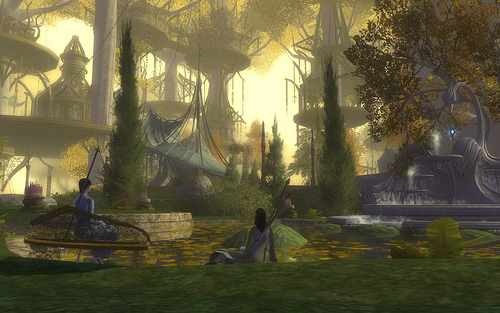
The only survivors of the Downfall were Elendil, Isildur, Anárion and those who followed them on their ships. As their Quenya names give away, they were Elf-friends and had no part in the rebellion against the Valar. In Middle-earth they founded the Realms in Exile, Arnor and Gondor. Sauron soon attacked Gondor, but he was defeated in the Battle of Dagorlad, and after seven years of siege he had to leave the Barad-dûr and was slain by Gil-galad, Elendil, and Isildur; only the last of these survived. So ended the Second Age of the World, but the Realms in Exile survived into the Third Age, and among the scholars of Arnor and Gondor the knowledge of Quenya was preserved.
The Kings of Arnor and Gondor used Quenya names, as had the faithful Númenorean Kings of old. (861 years into the Third Age, however, Arnor was divided into the petty realms of Arthedain, Rhudaur, and Cardolan; the Kings of these realms used Sindarin names.) The Stewards of Gondor also used Quenya names until the time of Mardil, the first of the Ruling Stewards (so called because there was no King in Gondor in the period 2050-3019 of the Third Age, and the Stewards had to take on all responsibilities). However, Mardil's successors ceased to use High-elven names. The Stewards never took the title of King, and they may have thought it would be presumptuous to use Quenya names after the manner of the Kings. But when Aragorn was crowned King in 3019, he called himself Elessar Telcontar in Quenya, following the ancient custom. Then the Fourth Age began, and the last of the Noldor set sail from the Havens and left Middle-earth for ever, returning to Aman. The last native speakers of Quenya were gone from our world, but as Gandalf pointed out to Aragorn, it was his task "to preserve what may be preserved" (LotR3/VI ch. 5) - including the knowledge of the Eldarin languages. We know that Aragorn gave a High-elven name to his son Eldarion, who succeeded him on the throne of Gondor when he died in the year 120 of the Fourth Age. Though little is known about this Age, there can be little doubt that as long as the realm of Gondor endured, Quenya was remembered.

Was a Ñoldorin prince, and the last in the line of the House of Fëanor, who lived in Middle-earth. He was a ruler of Eregion in the Second Age, and a master smith. He is remembered primarily for his creation of the three greatest Elven Rings of Power: Vilya, Narya, and Nenya.
Celebrimbor was the son of Curufin, who was the fifth son of Fëanor (son of Finwë and his first wife Miriel) and Nerdanel. During the First Age, he lived with his father in Nargothrond, but he took no part in the deeds of Curufin and Celegorm regarding Lúthien, Beren, and Finrod. He repudiated his father Curufin's deeds and did not follow his father and uncle when they were expelled from Nargothrond.
Celebrimbor settled in Eregion in the Second Age and started dealing with the dwarves of the realm of Khazad-dûm. In SA 1500, Sauron, calling himself Annatar ("Lord of Gifts"), befriended the Ñoldor of Eregion. He claimed to be an emissary of the Valar, especially Aule, and instructed them in the art of ring-making. Celebrimbor distrusted him, but the smiths of Eregion were deceived. Under the guidance and instruction of Sauron, the smiths openly made rings to learn the craft, but unknown to them the craft taught by Sauron incorporated a binding magic into the rings.
In secret, Sauron forged the One Ring, a master ring that would rule all the lesser rings, to enable him to rule Middle-earth via its influence over those who used the other rings. When Sauron placed the One Ring on his finger, claiming dominance over all the Rings of Power and their bearers, the elves knew his true identity and intentions. Celebrimbor and the elves of Eregion defied Sauron by withholding the other rings from him. The greatest of the rings (aside from the One Ring) were created by Celebrimbor himself, and these were never touched by Sauron and thus were uncorrupted by him, although they were still subject to the One Ring. These were the three Rings of the Elves, the fairest of the Rings of Power. Celebrimbor named them Vilya, Narya, and Nenya after the principal Middle-earth elements of air, fire and water, respectively. He sent the three rings away for safekeeping: Vilya and Narya to Gil-galad in Lindon; and Nenya to Galadriel in Lórien.
Sauron retaliated by attacking Eregion, laying waste to the realm. Celebrimbor was captured in the chaos and was forced, under torture, to disclose where the lesser rings were, but he would not reveal the whereabouts of the three greatest of them that he had sent away for safekeeping. Celebrimbor died from his torment; his body was shot with arrows and hung upon a pole, and was later paraded as a banner as Sauron attacked the elves. He was the last direct descendant of the line of Fëanor, save perhaps for his father's brother Maglor, whose fate is unknown and is said by some legends to still wander the shores of the Sea.
Unlike both his father and his grandfather, Celebrimbor was portrayed as being both selfless and kind, and was neither prideful nor covetous of that which he created. He was described to have an "almost Dwarvish obsession with crafts"; he became a famous artificer and smith in both Gondolin and Eregion. His love for crafts took him to Eregion, where he was introduced to a precious metal and called it Mithril. Mithril was mined by Dwarves in their nearby Mine Realm of Khazad-dum, later renamed Moria. Great friendship with the Dwarves of Moria developed, skills and secrets were shared between the two peoples for many years via The High Road which was built between the two realms. But a long period of peace would not last, for upon realizing the trap which Sauron had devised for him, Celebrimbor was filled with anxiety and fear for his people, and was later described as the heroic defender of Eregion.

Celeborn was of the Sindar, a kinsman of Thingol, so he had never been to Valinor, yet he was entitled to go there like all elves. Galadriel had been born there, being a Noldo, and wanted to go back. But she had lived with Celeborn for three ages of Middle-Earth. It seems wrong that she just dumped him.
To answer your question we must first figure out who Celeborn (Sindarin: "Silver Tree" or "Silver-tall" ... not to be confused with Celeborn the White Tree of Tol Eressëa) was.
Would you like to look behind Door Number One a.k.a. The Silmarillion version? In which Celeborn was a Sindarin elf living in the Maia Melian's realm of Doriath where Galadriel met him.
“Galadriel his sister went not with him to Nargothrond, for in Doriath dwelt Celeborn, kinsman of Thingol, and there was great love between them. Therefore she remained in the Hidden Kingdom, and abode with Melian, and of her learned great lore and wisdom concerning Middle-earth.”
How about Door Number Two a.k.a. The Lord of the Rings Book Two Chapter Seven version? In which Celeborn was a Nandorin elf already living in Lórien where Galadriel met him.
"He has dwelt in the West since the days of the dawn, and I have dwelt with him years uncounted; for ere the fall of Nargothrond or Gondolin I passed over the mountains, and together through ages of the world we have fought the long defeat."
Or perhaps Door Number Three a.k.a. The Lord of the Rings Appendix B version? In which Celeborn was a Sindarin elf of noble blood living in Círdan's realm where Galadriel met him.
"In Lindon south of the Lune dwelt for a time Celeborn, kinsman of Thingol ..."
Options 1 and 3 are a tad bit hinky because Galadriel was also closely related to Thingol, through her mother Eärwin who was the daughter of Thingol's brother Olwë. Celeborn was the son of Galadhon, the son of Thingol's brother Elmo. Which would make Celeborn and Galadriel kissing cousins, so to speak.
Okay, after all that genealogical pondering where are we? Oh yes, your question "Why did Galadriel abandon Celeborn at the end of the Third Age?"
In a word, because she was finished with Middle-earth. Galadriel had accomplished everything possible for an elf in the Third Age of Middle-earth, including single-handedly casting down Sauron's fortress of Dol Guldur.
More than that, Galadriel had at last pierced through the seductive illusion of the idea of rulership itself. She had come to Middle-earth in the ancient days before the rising of the Moon or Sun because "... she yearned to see the wide unguarded lands and to rule there a realm at her own will."
Yet this was the identical trap into which first the Vala Melkor and then the Maia Sauron had fallen into. Their dreams of rulership had also started out nobly, in honor of their conception of the design of Eru Ilúvatar. In her wisdom, and after untold millennia of bitter experience, Galadriel was able to overcome this alluring but ultimately unfulfilling desire. Thus she earned the pardon of the Valar and was allowed to take ship to Valinor.
But Celeborn wasn't ready to go.
For one thing, while Galadriel yearned to return to the home of her birth Celeborn was a Moriquendi elf who had never been to Valinor and was quite content living in the land of his birth. While unlikely, it's possible he may have been old enough to have been among the elves who refused Oromë's summons to the Great Journey.
Less charitably, at the start of the Fourth Age of Middle-earth Celeborn had delusions of grandeur wherein he would split the rulership of the forest of Mirkwood, renamed Eryn Lasgalen (Sindarin: "The Wood of Greenleaves") with King Thranduil.
“But after the passing of Galadriel in a few years Celeborn grew weary of his realm and went to Imladris to dwell with the sons of Elrond. In the Greenwood the Silvan Elves remained untroubled, but in Lórien there lingered sadly only a few of its former people, and there was no longer light or song in Caras Galadhon.”
Despite his vaunted wisdom (Galadriel: "For the Lord of the Galadhrim is accounted the wisest of the Elves of Middle-earth ...") Celeborn remained unable to see the proverbial writing on the wall. That the age of the elves in Middle-earth had come to an end and that they were doomed to "... dwindle to a rustic folk of dell and cave, slowly to forget and to be forgotten."
There is an old saying that may apply here: "We can be knowledgable with another person's knowledge but we cannot be wise with another person's wisdom."
So Galadriel had no choice but to leave Celeborn to his folly until he too drank the dregs of bittersweetness from his alloted cup of life. Tolkien gave us a foreshadowing of this in Celeborn's parting words to Aragorn II Elessar in Fangorn Forest:
"Kinsman, farewell! May your doom be other than mine, and your treasure remain with you to the end!"
Besides, Galadriel was romantically involved with Gandalf the White (see Could there ever have been a romantic angle between Galadriel and Mithrandir(Gandalf)?). I'm betting she spent a lot of time in Gandalf's cabin on that long, sweet cruise to Tol Eressëa.
Celeborn eventually wised up and, as usual, followed Galadriel's lead.
"... at last he sought the Grey Havens, and with him went the last living memory of the Elder Days in Middle-earth."
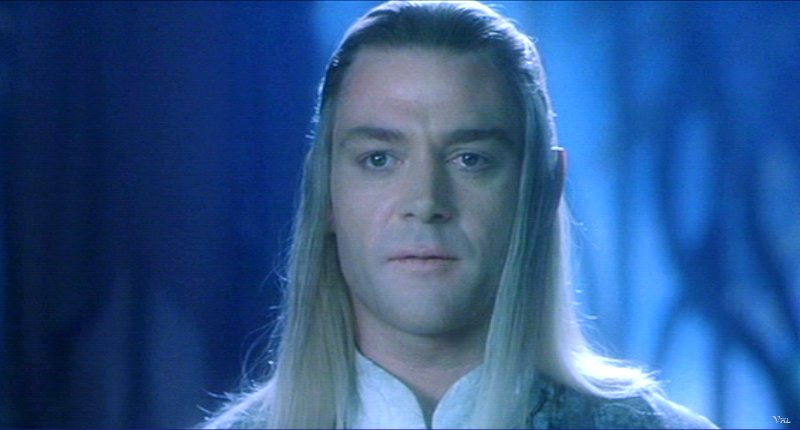
Celeborn was the Lord of Lothlórien, and his wife was Galadriel, Lady of the Golden Wood. Celeborn was said to be one of the wisest Elves in Middle-earth at the end of the Third Age.
During the War of the Ring, Celeborn defended Lothlórien and led the assault on the Enemy castle of Dol Guldur. He remained in Middle-earth for a time at the beginning of the Fourth Age, but eventually he joined his wife in the Undying Lands.
Celeborn was a Prince of Doriath and a kinsman of Thingol, the King of Doriath. Celeborn was said to be the grandson of Thingol's brother Elmo. Celeborn's father was Galadhon and he had a brother named Galathil.
First Age
Around FA 52, Galadriel came to Doriath. Galadriel was one of the Ñoldor who came to Middle-earth wishing to see the lands and rule a realm of her own. She came with the second 'group' of elves from Aman with Fingolfin and Finrod.[note 1] Celeborn and Galadriel fell in love and married each other.
It is not clear how long Celeborn and Galadriel dwelled in Beleriand. According to one story, they left Beleriand and crossed the Blue Mountains into Eriador before the Fall of Nargothrond in FA 495, but according to another story they remained in Beleriand until the end of the First Age.
Around FA 502, King Thingol of Doriath summoned dwarf craftsmen to set a Silmaril in Nauglamir, the fabled jeweled Necklace of the Dwarves. The dwarf craftsmen coveted the necklace and especially the Silmaril, and they demanded that Thingol give it to them. When Thingol refused, they killed him and took the necklace set with the Silmaril. The Dwarven craftsmen were pursued by elves of Doriath, who killed the Dwarves and retrieved the necklace. However, two Dwarves escaped and returned to Nogrod in the Blue Mountains and rallied their kinsmen to seek vengeance on the Elves of Doriath. An army of Dwarves attacked Doriath and defeated the elves. They took the necklace once more, but Beren again reclaimed it.
Doriath was briefly re-inhabited by Beren's son Dior Eluchíl, but the sons of Feanor came to try to take the Silmaril. Though Dior's daughter Elwing escaped with the Silmaril, Dior was killed and Doriath was ruined and abandoned.
Celeborn's distrust of Dwarves began at this time. His role in these events is unknown, although in one account it is written that Celeborn escaped the sack of Doriath.
The First Age ended with the War of Wrath and the defeat of Morgoth. Beleriand was ruined and sank beneath the Sea. Many of the Ñoldor returned to the Undying Lands with the pardon of the Valar, but Galadriel remained in Middle-earth with Celeborn.
Second Age
Celeborn and Galadriel probably lived for a time in Lindon, a coastal region west of the Blue Mountains. Gil-galad was the High King of the elves who dwelled in Lindon. However, many of the elves in Harlindon - the part of Lindon south of the Gulf of Lune - were Sindarin elves like Celeborn, and he may have ruled a fiefdom there under Gil-galad.
At some time early in the Second Age, Celeborn and Galadriel are said to have moved eastward into Eriador with a number of Elves in their following. They may have lived for a while near Lake Evendim. Their daughter Celebrian may have been born during this time. They began to move eastward again around the year SA 700 of the Second Age because Galadriel sensed a growing evil in Middle-earth that she felt duty-bound to oppose.
The realm of Eregion was founded in SA 750, and Galadriel and Celeborn are said to have dwelled there for a time along with Celebrimbor and the Elven-smiths. The Elves of Eregion had dealings with the Dwarves of Khazad-dûm nearby, but Celeborn still distrusted Dwarves and would not enter Khazad-dûm, although the Dwarves there had nothing to do with the destruction of Doriath.
The Elves of Eregion also had contact with the Elves of Lothlórien on the other side of the Misty Mountains. According to one story, Galadriel went to dwell in Lothlórien around SA 1350 to SA 1400 while Celeborn remained in Eregion. However, in other versions of the story both Galadriel and Celeborn stayed in Eregion.
Sauron came to Eregion in a fair disguise as Annatar the "Lord of gifts" in SA 1200 and deceived the Elven-smiths, who began forging the Rings of Power under his instruction in SA 1500. Sauron forged the One Ring to rule the others around SA 1600, and Celebrimbor hid from him the Three Elven Rings of power that he had made without Sauron knowing of its creation and help. Enraged, Sauron attacked Eregion in SA 1697.
Celeborn led a sortie from Eregion to meet the vanguard of Sauron's army. He was able to drive the enemy back long enough to join forces with Elrond, who brought reinforcements from Lindon. But Sauron's army was greater than their combined forces and Eregion soon fell. Celebrimbor was killed, and Sauron took the Nine Rings and at least six of the Seven rings. Sauron would eventually be driven back to Mordor in SA 1701.
The movements of Celeborn and Galadriel after the fall of Eregion are unclear. Celeborn may have gone to Lothlórien to help strengthen their defenses against Sauron. He and Galadriel may have lived there for a time, but they did not become the rulers of Lothlórien then. The king of Lothlórien at that time was Amdír, who was killed in the War of the Last Alliance at the end of the Second Age and was succeeded by his son Amroth.

Third Age
Celeborn and Galadriel may also have lived for a while in Rivendell, the home of Elrond. At some point, they may have travelled to the coastal region of Belfalas in the south to be near the sea.
Celeborn and Galadriel's daughter Celebrian married Elrond in TA 109. Elrond and Celebrian had three children: twin sons Elladan and Elrohir, born in TA 130, and a daughter Arwen, born in TA 241.
Around TA 1050, the Necromancer, who was actually Sauron, built the stronghold of Dol Guldur across the Anduin from Lothlórien. Celeborn and Galadriel are said to have returned to Lothlórien to investigate the Necromancer and ensure the safety of Lothlórien. But after a time, they once again departed, possibly for Rivendell. Lothlórien remained under the rule of King Amroth.
A Balrog awoke in Khazad-dum in TA 1980. Many of the Elves of Lothlórien fled, including Amroth's lover Nimrodel. Amroth followed Nimrodel and he later perished at sea. Lothlórien was left without a leader, so Celeborn and Galadriel returned there and became the Lord and Lady of Lothlórien in TA 1981. They dwelled on a flat in Caras Galadhon, the City of the Trees.
Celebrian was on her way to Lothlórien to visit her parents in TA 2509 when she was captured by orcs in caradhras. Her sons Elladan and Elrohir rescued Celebrian, but the horror of the experience remained with her and she decided to leave Middle-earth the next year to dwell in the Undying Lands.
In TA 2941, Sauron was driven out of Dol Guldur by the White Council - of which Galadriel was a member. However, Sauron had been prepared for the attack and returned to Mordor. He sent Nazgûl led by Khamul to occupy Dol Guldur.
Aragorn came to Lothlórien in TA 2980 and became betrothed to Arwen, who was there visiting her grandparents.
War of the Ring
In December of 3018, Elladan and Elrohir brought word to Celeborn and Galadriel of the Fellowship's quest to destroy the One Ring. The Fellowship arrived in Lothlórien on January 15, 3019, and was brought to Caras Galadhon to meet Celeborn and Galadriel on January 17.
Celeborn at first welcomed Gimli despite his distrust of Dwarves and said he hoped that there could be friendship between their peoples once more. Then he learned that the Balrog had been disturbed by an expedition of Dwarves to Khazad-dum led by Balin several years before, and that the Balrog had attacked the Fellowship resulting in the loss of Gandalf the Grey. Celeborn was angry at first and regretted allowing the Fellowship to enter Lothlórien, but Galadriel soothed him and he apologized to Gimli.
Celeborn promised to help the Fellowship in any way he could. On the eve of the Fellowship's departure from Lothlórien, he discussed what route they might take, and offered them boats to ease their journey down the Anduin. The next day on February 16, Celeborn and Galadriel prepared a feast for the Fellowship and gave them gifts. Celeborn gave them further advice about navigating the Great River.
Lothlórien was attacked thrice by forces from Dol Guldur during the War of the Ring: on March 11, 15, and 22. Each time, the Galadhrim led by Celeborn and Galadriel repelled them. After the destruction of the One Ring and Sauron's defeat, Celeborn led a force across the Anduin and captured Dol Guldur on March 28. The shadow was lifted from Mirkwood.
On April 6, Celeborn met Thranduil, the King of the Woodland Realm, in Mirkwood. They renamed the forest the Wood of Greenleaves. Thranduil retained kingship of the northern part of the forest, while the center part was given to the Beornings and the Woodmen. Celeborn claimed the southern part of the forest below the Narrows to be part of Lothlórien. This region was named East Lórien.
Celeborn and Galadriel accompanied their granddaughter Arwen to Minas Tirith, where she wed Aragorn on Midyear's Day. Celeborn and Galadriel then travelled to Rohan and attended the funeral of King Theoden. On the way home, they met with Treebeard at Isengard.
When Celeborn and Galadriel parted from Aragorn, Celeborn said to his granddaughter's husband: "Kinsman, farewell! May your doom be other than mine, and your treasure remain with you to the end!"
Celeborn may have been anticipating the day when his own wife would depart for the Undying Lands while he remained in Middle-earth. On September 13, Celeborn and Galadriel crossed the Redhorn Gate to return to Lothlórien.
Fourth Age
Galadriel left Middle-earth to return to the Undying Lands in 3021 at the end of the Third Age. Celeborn remained in Lothlórien, but after a few years he began to grow weary. He went to Rivendell to live with his grandsons Elladan and Elrohir for awhile in the early part of the Fourth Age. Eventually, Celeborn went to the Grey Havens and sailed for the Undying Lands where his wife and daughter dwelled. It is said that "with him went the last living memory of the Elder Days in Middle-earth.
"Three Rings for the Elven-kings under the sky,
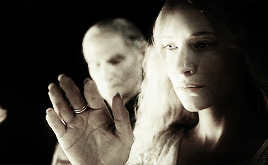

Seven for the Dwarf-lords in their halls of stone,
Nine for Mortal Men doomed to die,
One for the Dark Lord on his dark throne
In the Land of Mordor where the Shadows lie.
One Ring to rule them all, One Ring to find them,
One Ring to bring them all and in the darkness bind them
In the Land of Mordor where the Shadows lie."
The Rings of Power were twenty magical rings forged in the Second Age, intended by Sauron to seduce the rulers of Middle-earth to evil. Nineteen of these rings were made by the elven-smiths of Eregion, led by Celebrimbor. These were grouped into three rings for the Elves, seven rings for the Dwarves, and nine rings for men. One additional ring, the One Ring, was forged by Sauron himself at Mount Doom. The nineteen lesser Rings were linked somehow to the power of the One, and were dependent on it. Their wielders could be controlled by the wielder of the One, and if the One was destroyed, their own powers would fade.
The Rings of Power were the masterwork of the elven-smiths of Eregion headed by Celebrimbor, who was descended from Fëanor. The impetus for their creation came from Sauron, who could at that time still assume an appearance fair enough to deceive at least some of the Elves. A total of nineteen Rings of Power were forged by the Elves, sixteen of which Sauron had a direct hand in creating. The greatest three Rings Celebrimbor crafted alone. Many other lesser rings were made, described in the The Silmarillion and by Gandalf, though they were generally considered as having been mere essays in the craft: practice, as it were, for the smiths. Sauron, however, planned to use the Rings to dominate the remaining Elves of Middle-earth. In accordance with this, he secretly forged the One Ring in the fires of Orodruin, seeking to bring all the rings and their wearers under his sway. However, when Sauron put the Ruling Ring on his finger, the Elves were immediately aware of him and took off their Rings. Furious at this turn of events, Sauron came against the Elves with open war and demanded that the Rings be given to him. Fortunately for the Elves, they were able to hide the greatest Three, but Sauron recovered the other sixteen. These he then gave to mortals: to the Dwarves and Men. Seven he gave to Dwarves, but Nine he gave to Men, knowing that they would most easily bend to his will. In time, the nine Men to whom the Rings were given became Nazgul, wraiths of great power under the command of Sauron. The Dwarf lords to whom the Seven were given became wealthy beyond measure, but they did not fall to Sauron's power. Instead, the Rings kindled in them an overwhelming greed for treasure, and so ruin was brought to each regardless.
According to Gandalf, one feature of the Rings of Power that appeared to be universal was that a mortal who wore any one of the Rings was granted a lifespan far beyond their natural one. It is likely that this is an unintended side-effect of the Rings' power, as Sauron originally intended for all the Rings to be worn by Elves, who were immortal to begin with. The individual who kept the Ring would not grow or obtain more life, however; they would merely continue until living became unendurable. Bilbo Baggins stated near the end of his time possessing the One that he was beginning to feel "thin and stretched", a sign that this process was beginning to affect him.
The three races given the Rings of Power
The Three that remained to the Elves were carefully hidden from Sauron. They were not created as weapons of war or as a means to dominate others; their purpose was to preserve the beautiful Elven domains where their wielders resided, and to aid in healing and resisting evil. However, they were still linked to the One Ring, and whoever wore it could, with effort, see the thoughts of those who wore the Three.
In the Silmarillion, it is indicated that the Seven Rings of the Dwarves were not fundamentally different from the Nine that were given to Men, for originally Sauron had intended the Seven and the Nine to reside in Elven hands so that he might control them. It is implied in that work that Sauron simply gave Men nine of sixteen lesser Rings because they were more easily controlled. However, the Nine and the Seven are referred to in other works as each being its own distinctive set. If they were different in their effects on their wielders or in the powers they conferred, it is not stated. It is also mentioned in Unfinished Tales that the Seven were created before the Nine. Sauron helped to create the Seven and the Nine, so it is likely that their powers and effects on their wielders were similar, even if each set was distinct. It is important to note that the fact that the Seven did not subdue the Dwarves is related to the resilient nature of the Dwarves themselves, not the Rings. It is likely that the effects of one of the Nine on a Dwarf would be the same as those of one of the Seven, and were a Man to wield one of the Seven, he would likely still become a wraith. The Three were fundamentally different because Celebrimbor, working alone, created them for specific purposes not in tune with Sauron's line of thought, and Sauron presumably did not know of their creation until after the fact.

The Three Rings of Celebrimbor, son of Curufin, were forged by Celebrimbor alone, and were never touched by Sauron. They were called Narya: Ring of Fire, held first by Gil-galad, who later gave it to Círdan and then to Gandalf; Nenya: Ring of Adamant, worn by Galadriel; and Vilya: Ring of Air, borne first by Gil-galad, who later gave it to Elrond. They remained hidden, and the whereabouts of the three were not openly revealed until the end of the Third Age, after the One Ring was destroyed, and the Dark Lord Sauron was overthrown. These rings are invisible instead of making the wearer invisible. Galadriel revealed her possession of one of the rings to Frodo while he was in Lothlórien after he saw her ring. This is because of his possession of the One Ring. Later, while traveling down the River Anduin, Frodo spoke of it to Aragorn, who admonished him not to speak of it outside of Lórien.
Each of the Three Rings had special properties, but their powers were limited. During The Council of Elrond, Elrond stated that neither he, nor Lórien, nor the Havens (the locations of the Three Elven Rings) had the power to withstand the might of Mordor.
Narya 
Narya, the Ring of Fire
Narya, also named the Ring of Fire or Red Ring, is one of the Three Rings.
According to Unfinished Tales, at the start of the War of the Elves and Sauron, Celebrimbor gave Narya to Círdan, Lord of the Havens of Mithlond, who kept it after Gil-galad's death. In the Third Age Círdan, recognizing Gandalf's true nature as one of the Maiar from Valinor, gave him the ring to aid him in his labors. It is described as having the power to inspire others to resist tyranny, domination, and despair (in other words, evoking hope from others around the wielder), as well as giving resistance to the weariness of time:
"Take now this Ring," he said; "for thy labors and thy cares will be heavy, but in all it will support thee and defend thee from weariness. For this is the Ring of Fire, and herewith, maybe, thou shalt rekindle hearts to the valor of old in a world that grows chill" (Círdan the Shipwright to Gandalf).
Narya was worn by Gandalf at the Grey Havens. It was a gold ring adorned with a red ruby.
In the extended edition of The Hobbit: The Battle of the Five Armies, Gandalf is shown wearing Narya, which was hidden with his magic until he was weakened by torture, but he is saved by Galadriel and his torturer killed before Sauron can learn of his ownership of the ring.
Nenya 
Nenya, the Ring of Water
Nenya, also named as the Ring of Adamant, the White Ring and the Ring of Water, is one of the Three Rings. The name is derived from the Quenya Nén meaning water.
Nenya is described as being made of mithril and set with a "white stone", presumably a diamond (this is never stated explicitly, although the usage of the word "adamant", an old synonym, is strongly suggestive). The ring is wielded by Galadriel of Lothlórien, and possessing radiance that matches that of the stars; while Frodo Baggins can see it by virtue of being a Ring-bearer, Samwise Gamgee tells Galadriel he only "saw a star through your fingers" (This appears in many editions as "finger" — which sounds more magical, since it suggests that her finger has somehow become transparent — but The Treason of Isengard, ch. 13, note 34, mentions it as an error.)
Nenya's power was preservation, protection, and possibly concealment from evil because it is stated about Lórien that "there is a secret power here that holds evil from the land." However, the fact that Orcs from Moria entered Lórien after the Fellowship of the Ring entered the forest and Lórien itself had suffered previous attacks from Sauron's Orcs sent from Dol Guldur suggests the power of the ring did not constitute military prowess. It was said that, protected as it was by Nenya, Lothlórien would not have fallen unless Sauron had personally come to attack it. Galadriel used these powers to create and sustain Lothlórien, but it also increased her longing for the Sea and her desire to return to the Undying Lands. After the destruction of the One Ring and the defeat of Sauron, its power faded along with the other Rings of Power. Galadriel bore Nenya on a ship from the Grey Havens into the West, accompanied by the other two Elven Rings and their bearers. With the Ring gone, the magic and beauty of Lórien also faded, along with the extraordinary mallorn trees that had lived for centuries, and it was gradually depopulated. By the time Arwen came there to die in FO 121, Lothlórien was deserted and in ruin.
Vilya 
Vilya, the Ring of Air
Vilya, the Ring of Air, Blue Ring, the Dominant Ring, or Ring of Sapphire is the greatest of the Three Rings.
When Sauron laid waste to Eregion, Vilya, along with Narya, was sent to the Elven-King Gil-galad far away in Lindon, where it was later given to Elrond, who bore it through the later years of the Second Age and all of the Third. As Gil-galad was the High King of the Ñoldor elves at the time of the rings' distribution it was thought that he was best fit to care for the most powerful of the three Elven rings.
Like the other two Rings of the Elves, Vilya was jeweled: it contained a great blue stone set in a gold band, which contributed to its titles as the Ring of Sapphire and the Blue Ring. Vilya was also called the Ring of Air, signifying its preeminence even over the other Rings of the Elves, since Vilya was the mightiest of these three bands (as mentioned in the ending chapter in The Return of the King). The exact power of Vilya is not mentioned. It is reasonable to speculate that it also possesses the power to heal and to preserve, as it is mentioned in The Silmarillion that Celebrimbor had forged the Three for these purposes, rather than to enhance the strengths of each individual bearers as the Seven, Nine, and the lesser rings did. There is some speculation that the ring controlled minor elements, considering the event where Elrond had summoned a torrent of water as the Nazgûl attempted to invade Rivendell. The ring can possibly possess the power to see the future, because Elrond can see the future as well. However, these powers may simply have been natural gifts of Elrond.
Upon Sauron's destruction, the power of Vilya faded, and it was taken over the sea by Elrond at the end of the Third Age.
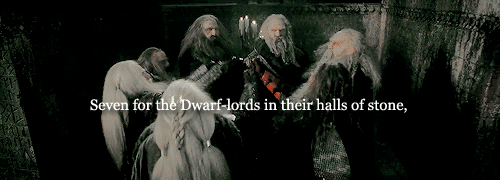
Sauron presented the Seven Rings to the Dwarf-lords (although according to dwarvish tradition the Elven smith Celebrimbor gave the mightiest to Durin III personally). Apparently one ring went out apeice to the head of each one of the seven dwarf clans: Durin's Folk aka "Longbeards"; Firebeards; Broadbeams; Ironfists; Stiffbeards; Blacklocks; Stonefoots.

Seven Rings by the Nobles Collection
The Dwarves used their Rings to establish their fabled treasure hoards (which in turn attracted dragons), but Sauron, according to portions of the Silmarillion, was unable to force the Dwarven bearers to submit to his will. Indeed, the rings did not even turn them invisible; they were immune to some of the more detrimental of the rings' effects. It is believed that the dwarves' natural hardiness, and the fact that it was only the more powerful dwarf lords who possessed them, made them resistant to Sauron's control. While it is not directly stated, the Rings presumably gave the Dwarf lords who wielded them a greatly increased life span, and they presumably did not age. The net effect of these rings was to bring vast wealth to the wearer and cause him to become extremely greedy, which ultimately led to the wielders' ruin. At the time of The Lord of the Rings four rings had been consumed by dragon fire and the rest re-acquired by Sauron. The mightiest of the Seven was taken from Thráin II, heir of Durin, who had been captured, imprisoned, and tormented by the Necromancer (Sauron in disguise) in TA 2845.
Shortly before the outbreak of the War of the Ring, Sauron's envoy approached Dain II Ironfoot in Erebor and offered to return the three surviving Rings to the dwarves, if they would help find the One Ring. Dain refused, knowing from the dwarves' long experience that Sauron was untrustworthy.
In the extended edition of The Hobbit: An Unexpected Journey, Gandalf expresses concern about the fate of Thrain's ring, identifying it as the last ring of the Seven not said to be in Sauron's power when he fell, with four destroyed and two taken by Sauron. In the extended edition of The Hobbit: The Desolation of Smaug, when Gandalf discovers Thrain in Dol Guldur, a flashback confirms that Thrain possessed one of the Seven during the attempt to retake Moria, with Azog having cut off the top of Thrain's left index finger to take his ring.

The nine rings for mortal men were those divided amongst those evil-hearted men doomed to become the Nazgûl, the Ringwraiths. These ring-bearers held rings that were under control by Sauron, for they became evil servents of him. None are mentioned specifically throughout the Lord of The Rings save their leader, the Witch-king of Angmar. His second-in-command is named in the Unfinished Tales as Khamûl, the Black Easterling.
The early Middle-earth Role Playing games name the eight other Ringwraiths, Er-Murazor (the Witch-king, of Númenórean race), Dwar, Ji Indur, Akhorahil, Hoarmurath (Númenórean), Adunaphel (female Númenórean), Ren and Uvatha, but none of these names are considered canon, and especially the idea of a female Ringwraith is unlikely within the context of Tolkien's work, although possible, given that three Númenórean Queens ruled under their own power, Tar-Ancalimë, Tar-Telperiën and Tar-Vanimeldë. There is also an unlikely precedent for evil female characters in the entities of Ungoliant and Shelob.
In "The Battle for Middle-earth 2: The Rise of the Witch-king", one of the Nine, given the non-canon name Morgomir, is the Witch-king's second-in-command in Angmar.
The line from Tolkien's epigraph, "Nine for Mortal Men doomed to die" refers to the fate of men, uniquely among the creations of Eru to pass beyond Arda to a destiny unknown to the elves. It was this uncertainty, and Men's envy of elven immortality in the Blessed Realm which Sauron exploited, leading to the destruction of Numenor.
The effects of the Nine on the Men were that they each acquired great power and wealth, became powerful Sorcerers (this effect presumably ended when they became the Ringwraiths) and appeared to have eternal life, for they did not age. After a time however, life became unendurable to them, and when they put the Rings on, they often beheld the phantoms and delusions of Sauron. One by one, according to the nature of the Man and his innate inability to resist evil, they fell under Sauron's permanent control, and became wraiths who did only Sauron's bidding. They remained permanently invisible, except to those Elves who had once dwelt in the Undying Lands (few indeed by the Third Age) and Maiar such as Sauron and the Wizards. They were also visible to whomever wore the Ruling Ring (whether the other Rings conferred this ability is unknown). This process also appeared to link their lives and power with Sauron's, making them little more than extensions of his will. When Sauron's power was weak, the wraiths themselves were also fairly powerless. As Sauron became stronger however, they became much more powerful, to the point where the Witch King was presumably able to match Gandalf the White in strength.
It is unclear where the Nine were physically kept. At the Council of Elrond the history of the Rings of Power is discussed, and it is stated that Sauron has "gathered the Nine to himself," although it is also said that "the Nine the Nazgûl keep." This could mean either that the Nazgûl wear their rings while in the service of Sauron, or it could mean that after they fell and became enslaved to his will Sauron took their rings and kept them in Barad-dûr as he did with the remaining Dwarf rings and set the Nazgûl to guard them. There is no mention of any of the Nine when the Nazgûl are seen, and most notably when the Witch-King was slain Tolkien does not describe him wearing a ring, nor did either Gandalf or Aragorn express concern about what happened to the ring afterwards. This implies that at the very least the Nazgûl don't wear their rings constantly, although they may sometimes put them on still.

The One Ring, secretly forged by Sauron in the heart of Mount Doom, had the power to dominate the other nineteen Great Rings. Sauron's intent was to command the minds of the other ring bearers through their rings of power. His original intention was for the Rings to be given to Elves of power and influence. Sauron then intended to forge the One Ring which, through the lesser rings, would allow Sauron direct influence over the thoughts of the other ring-bearers. Had it succeeded perfectly, Sauron would have achieved dominance over the Elves with no military action required. However, for this plan to be successful the Ruling Ring would have to be significantly stronger than the other rings, and Sauron put a great amount of his own power into the ring in order to achieve this. As the Ruling Ring, it had all the powers of the other rings, but to a far greater extent, and had some powers uniquely its own. While Sauron's plan didn't succeed perfectly, the existence of the One Ring on his finger meant that the other rings, with which many kingdoms had been built, could not be used safely. Additionally, intentionally or not, Sauron's personal power was greatly enhanced so long as he wore the Ring, giving him military might the likes of which he could never have otherwise achieved.

The words found upon the One Ring forged by Sauron in Mount Doom.
Unlike the other great rings, the One Ring held no gem and had no intricate designs on it, at least at first glance. To an ordinary layman it would appear as a simple golden band. Heating the ring in even a small fire, however, would reveal part of Sauron's incantation in an elvish script written along the ring. According to Isildur, Sauron's hand was "black and yet burned like fire." (Fellowship of the Ring) He also references how the script was visible on the ring while Sauron wore it. It was virtually indestructible, and no craft or power possessed by the Elves or Gandalf could harm it in any way. It also appeared to have a will of its own (or at least, the ability to independently carry out Sauron's will since it contained a large portion of his being), and could expand or shrink by itself.
It was Isildur who cut the ring off Sauron's hand. He had the chance to destroy the One in the very chambers where it was forged, but was corrupted by the ring, and spared it. Later it betrayed him, resulting in his death. It was found, 2500 years later, by a Hobbit like creature named Dèagol. Dèagol was then killed by his cousin, Smèagol (later Gollum), who then took the Ring for himself. Smèagol was quickly corrupted, but had a strong physical resistance to the Ring, and "for 500 years the Ring poisoned his mind." Later, a Hobbit, Bilbo Baggins found Smèagol living under the Misty Mountains. Bilbo got the Ring by chance, and at the end of all his adventures he still had it. Later the One was passed down to Frodo Baggins, who was forced to flee to Rivendell, chased by Black Riders. He was chosen there to take the chance Isildur threw away: to destroy the One in the fires of Mount Doom. Upon finding Frodo (as he believed) dead, Sam took the ring to protect it. After discovering Frodo alive, Sam returned the ring. Frodo, after a long and difficult journey, ultimately failed in his effort to destroy the One Ring. At the edge of the lava, the Ring corrupted Frodo, and he tried to take it to keep it for himself. Sméagol came up behind him, bit off his finger and the Ring, and fell off the edge into the lava below. The One Ring was destroyed, and Sauron defeated.
Translations of the Ring Poem
English:
Three Rings for the Elven-kings under the sky,
Seven for the Dwarf-lords in their halls of stone,
Nine for Mortal Men doomed to die,
One for the Dark Lord on his dark throne
In the Land of Mordor where the Shadows lie.
One Ring to rule them all, One Ring to find them,
One Ring to bring them all and in the darkness bind them
In the Land of Mordor where the Shadows lie.
Sindarin:
Corf neledh 'nin Ellerain nui venel,
Odo'ni Nauhírath vi rynd gonui în,
Neder'ni Fîr Fírib beraid fíred,
Êr am Morchír bo morn-orchamm dîn
Vi Dor e-Mordor ias i-Ndúath caedar.
Er-chorf a thorthad hain bain, Er-chorf a chired hain,
Er-chorf a thoged hain bain a din fuin an nuded hain
Vi Dor e-Mordor ias i-Ndúath caedar.
Quenya:
Neldë Cormar Eldaron Aranen nu i vilya,
Otso Heruin Naucoron ondeva mardentassen,
Nertë Firimë Nérin yar i Nuron martyar,
Minë i Morë Herun mormahalmaryassë
Mornórëo Nóressë yassë i Fuini caitar.
Minë Corma turië të ilyë, Minë Corma hirië të,
Minë Corma hostië të ilyë ar mordossë nutië të
Mornórëo Nóressë yassë i Fuini caitar.
Black Speech:
Shre nazg golugranu kilmi-nudu,
Ombi kuzd-durbagu gundum-ishi,
Nugu gurunkilu bard gurutu,
Ash burz-durbagu burzum-ishi,
Daghburz-ishi makha gulshu darulu.
Ash nazg durbatulûk, ash nazg gimbatul,
Ash nazg thrakatulûk, agh burzum-ishi krimpatul
Daghburz-ishi makha gulshu darulu.
Khuzdul:
Gem ruthukhmuzûm khuthûzhmulhûkh undu mingal,
Hadud khazâdzubûdul ni aban-dumizd,
Tegur amradulûnh kigh maradî,
Ze dushelzabadul ayazabadogimhu.
Ni Nargûnzdin, uznîn binaganagî.
Ze ruthukhmizim nazurîzdel,
Ze ruthukhmizim umkhûhîzd,
Ze ruthukhmizim tashfabîzdel ra ni narag balhîzd
Ni Nargûnzdin, uznîn binaganagî.
First of all, this is my favorite part of Sillmarillion. -Astapor

Although Sauron long knew that Men were easier to sway, he sought to bring the Elves into his service, as they were far more powerful. So after about a thousand years after the War of Wrath, Sauron decided that the Valar had forgotten about Middle-earth and he once again turned to evil.
After lying hidden and increasing his power in secret, Sauron put on a fair visage, calling himself Annatar, the Lord of Gifts, and in S.A. 1200 he befriended the Elvish smiths of Eregion, counselling them in arts and magic. He was never welcome in Lindon as Elrond and Gil-galad did not trust him and refused to treat with him (which included Galadriel too), although they never realised who he truly was. Elsewhere he was gladly received, especially in Eregion where the Elvish smiths learned much from him as their thirst for knowledge was great.
Under Sauron's tutelage the Gwaith-i-Mírdain, under the leadership of Celebrimbor, grandson of Fëanor, became more skilled than anyone else, save for Fëanor himself. In the year S.A. 1500, when they reached the very height of their power, the Elves began the forging of the Rings of Power, but Sauron knew all their secrets and in S.A. 1600 - ten years after the completion of the Rings of Power - Sauron created The One Ring to control the bearers of the other Rings. For this he invested most of his own power into the Ring as he forged it.

But the Elves were not so easily ensnared, and as soon as Sauron put on the One Ring they and Celebrimbor were aware of him, and realised they were betrayed. They hid their Rings from Sauron and did not use them. Sauron demanded that the other Rings be given to him, for they would not have been made without his knowledge. The Elves refused, and the War was inevitable.
In this time Sauron became known as the Dark Lord of Mordor. He raised Barad-dûr, the Dark Tower, near Mount Doom; constructed the Black Gate of Mordor to prevent invasion; and raised massive armies of Orcs, Trolls, and Men, chiefly Easterlings and Southrons. Sauron's power reached its zenith 700 years after Mordor's creation, in the 17th century of the Second Age.
The War of the Elves and Sauron was a bloody conflict which destroyed Eregion and devastated much of Eriador. Celebrimbor was slain and his body impaled on a spike paraded at the head of Sauron's legions. The Elves were pushed back almost to the Blue Mountains, while their Dwarf allies (who had also rejected Sauron) retreated behind the walls of Moria where Sauron could not assail them. Sauron was master of almost all of Middle-earth beyond the coasts, but the Númenóreans, the powerful Men descended from the line of Beren and Lúthien, who lived on the island of Númenor in the sea between Middle-earth and Valinor, responded to the Elves' call for aid and sent a relief force. The combined armies rallied and were able to defeat Sauron's armies in Eriador after heavy fighting, and the Dark Lord fled back to Mordor with little more than his own bodyguard and a handful of orcs.

As the Elves had failed him, he had decided to distribute the Rings of Power to Men and Dwarves. The Dwarves also failed him, as they proved too hardy and resistant to their corruptive power; however the nine Men were corrupted and eventually faded, being turned into the Nazgûl (Ringwraiths), his chief servants.
Nonetheless, while Sauron's subsequent power never quite matched the height it had during the War with the elves, many of his most powerful enemies' homelands had been devastated. Relative to his enemies, Sauron's empire was actually in a stronger position than it used to be. His empire continued to expand to dominate barbarian Men to the far south and east. Throughout this, Sauron remained faithful in his old allegiance, building temples to the worship of Morgoth, where human sacrifice was practiced. Because of this, towards the end of the Second Age, Sauron assumed the titles of Lord of the Earth and King of Men.
This offended the arrogant Númenóreans who had already started to fall under the Shadow. The proud Númenóreans came to Middle-earth with great force of arms, and Sauron's forces fled. Realizing he could not defeat the Numenoreans with military strength, Sauron allowed himself to be taken as a hostage to Númenor by King Ar-Pharazôn. There, he quickly grew from captive to advisor and was known as Tar-Mairon; he converted many Númenóreans to the worship of Morgoth, becoming High Priest of the Cult of Melkor. He had the White Tree cut down and in its place raised a great temple in which he performed human sacrifices, persecuting those who were still Faithful. Finally, he convinced the king to rebel against the Valar and attack Valinor itself, claiming they would gain immortality. Eru, the supreme god, then directly intervened: Númenor was drowned under the sea, and the great navy of Númenor was destroyed.
Sauron was on Númenor in the Temple of Melkor and was caught in the ensuing flood. However his spirit survived, although severely weakened by the destruction, and (presumably carrying the One Ring) fled back to Middle-earth.
Sauron's spirit returned to Mordor, where he slowly rebuilt his strength during the time known as the Dark Years, and he was unable to assume a fair shape. From this point on he started to rule through terror and force.

Meanwhile, a few faithful Númenóreans, led by Elendil, were saved from the flood, and they founded Gondor and Arnor in Middle-earth. Sauron still considered them his hated enemies and he launched a pre-emptive attack on Gondor in S.A. 3429. These Men, led by Elendil and his sons, formed the Last Alliance with the Elves of Lindon under the Elven-king Gil-galad, and together they fought Sauron in the War of the Last Alliance. The Alliance advanced against Mordor and defeated Sauron's forces in the Battle of Dagorlad and finally laid siege before Barad-dûr.
The siege lasted for seven years until S.A. 3441, when Sauron left his fortress engaging in direct combat. Elendil and Gil-galad fought Sauron and vanquished him, but both were killed. Isildur, son of Elendil, cut the One Ring from Sauron's finger and claimed it. Later, the Ring betrayed him and was lost for more than two thousand years. After his defeat in the War of the Last Alliance, Sauron had lost his ability to form a physical body for a great while.
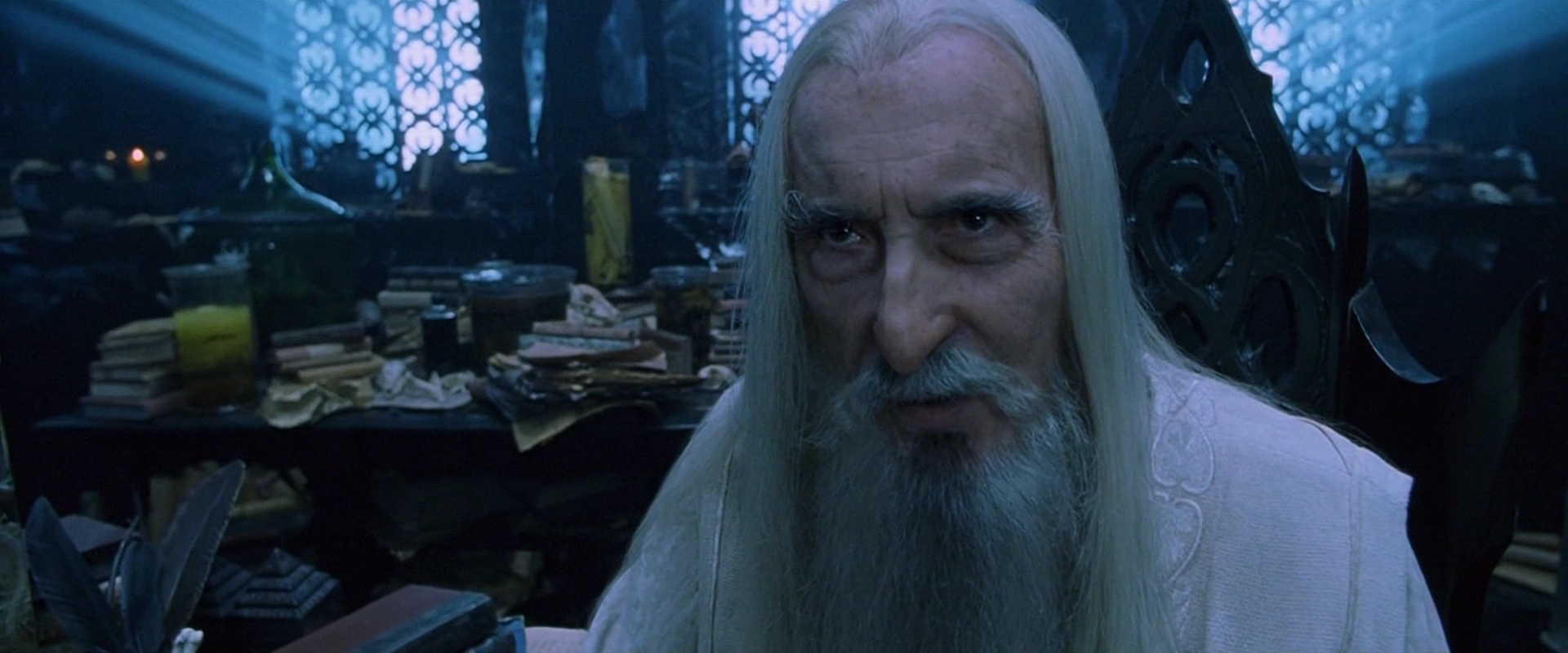
ANSWER: In “The Council of Elrond” Gandalf explains his absence to Frodo and others by relating how he was deceived and trapped by Saruman in Isengard in the Third Age year 3018. As part of his story Gandalf says:
‘Late one evening I came to the gate, like a great arch in the wall of rock; and it was strongly guarded. But the keepers of the gate were on the watch for me and told me that Saruman awaited me. I rode under the arch, and the gate closed silently behind me, and suddenly I was afraid, though I knew no reason for it.
‘But I rode to the foot of Orthanc, and came to the stair of Saruman and there he met me and led me up to his high chamber. He wore a ring on his finger.
Soon after Saruman says:
‘ “The Nine have come forth again,” I answered. “They have crossed the River. So Radagast said to me.”
`”Radagast the Brown! ” laughed Saruman, and he no longer concealed his scorn.
“Radagast the Bird-tamer! Radagast the Simple! Radagast the Fool! Yet he had just the wit to play the part that I set him. For you have come, and that was all the purpose of my message. And here you will stay, Gandalf the Grey, and rest from jourjourneys. For I am Saruman the Wise, Saruman Ring-maker, Saruman of Many Colours! “
Many readers have asked what the significance of this statement was. Did Saruman make a Ring of Power for himself? I have often argued that J.R.R. Tolkien certainly meant this, for near the end of The Lord of the Rings as Gandalf, the Hobbits, and the Elves of Lorien and Rivendell are returning north through Dunland they come upon Saruman and he makes a very interesting comment:
On the sixth day since their parting from the King they journeyed through a wood climbing down from the hills at the feet of the Misty Mountains that now marched on their right hand. As they came out again into the open country at sundown they overtook an old man leaning on a staff, and he was clothed in rags of grey or dirty white, and at his heels went another beggar, slouching and whining.
‘Well Saruman!’ said Gandalf. ‘Where are you going?’
‘What is that to you?’ he answered. ‘Will you still order my goings, and are you not content with my ruin?’
‘You know the answers,’ said Gandalf: ‘no and no. But in any case the time of my labours now draws to an end. The King has taken on the burden. If you had waited at Orthanc, you would have seen him, and he would have shown you wisdom and mercy.’
‘Then all the more reason to have left sooner,’ said Saruman; ‘for I desire neither of him. Indeed if you wish for an answer to your first question, I am seeking a way out of his realm.’
‘Then once more you are going the wrong way,’ said Gandalf, ‘and I see no hope in your journey. But will you scorn our help? For we offer it to you.’
‘To me?’ said Saruman. ‘Nay, pray do not smile at me! I prefer your frowns. And as for the Lady here, I do not trust her: she always hated me, and schemed for your part. I do not doubt that she has brought you this way to have the pleasure of gloating over my poverty. Had I been warned of your pursuit, I would have denied you the pleasure.’
‘Saruman,’ said Galadriel, ‘we have other errands and other cares that seem to us more urgent than hunting for you. Say rather that you are overtaken by good fortune; for now you have a last chance.’
‘If it be truly the last, I am glad,’ said Saruman; ‘for I shall be spared the trouble of refusing it again. All my hopes are ruined, but I would not share yours. If you have any.’ For a moment his eyes kindled. ‘Go!’ he said. ‘I did not spend long study on these matters for naught. You have doomed yourselves, and you know it. And it will afford me some comfort as I wander to think that you pulled down your own house when you destroyed mine. And now, what ship will bear you back across so wide a sea?’ he mocked. ‘It will be a grey ship, and full of ghosts.’ He laughed, but his voice was cracked and hideous.
Here Saruman appears to be referring to the failure of the Rings of Power, which all “went out” the moment the One Ring was destroyed. It was because the Rings lost their powers that Elrond and Galadriel had to leave Middle-earth, for as keepers of Rings they had felt the burden of many thousands of years bear down upon them more than any other Elves.
The Elves of Eregion had created the Rings of Power to delay the effects of Time, which ultimately would result in the Elves fading and losing their corporeality, unless they took ship over Sea to Aman. Saruman’s taunt to Galadriel and Elrond seems to suggest that they were going to begin fading, or had already begun to fade, and so would soon be rendered no more than dis-embodied ghosts.
But one other aspect of the various Rings of Power was that their makers had to invest part of their own native strengths into the Rings themselves, externalizing part of themselves (as Tolkien put it in one of his letters). The Three Rings were made by Celebrimbor, who had already been slain thousands of years before. After the death of Sauron Saruman remained the only living maker of a Ring of Power, but because he devised his Ring according to the lore he had studied (which was the remnant of the secrets of the Elven-smiths of Eregion and such of Sauron’s teachings as had been preserved) Saruman’s ring was also subject to Sauron’s One Ring. Hence, when the One Ring failed Saruman’s ring would also have to fail.
This would also explain the deeper meaning of Frodo’s own words in the Shire, when he forbade the Hobbits from slaying Saruman: “‘…He was great once, of a noble kind that we should not dare to raise our hands against. He is fallen, and his cure is beyond us; but I would still spare him, in the hope that he may find it.'” I don’t think that Frodo meant only that Saruman had fallen to a corrupt state — but that he was no longer as powerful as he had once been. Gandalf and Treebeard alluded to Saruman’s diminished state when they spoke at Isengard after the Downfall of Sauron:
‘No, not dead, so far as I know,’ said Treebeard. ‘But he is gone. Yes, he is gone seven days. I let him go. There was little left of him when he crawled out, and as for that wormcreature of his, he was like a pale shadow. Now do not tell me, Gandalf, that I promised to keep him safe; for I know it. But things have changed since then. And I kept him until he was safe, safe from doing any more harm. You should know that above all I hate the caging of live things, and I will not keep even such creatures as these caged beyond great need. A snake without fangs may crawl where he will.’
‘You may be right,’ said Gandalf; ‘but this snake had still one tooth left, I think. He had the poison of his voice, and I guess that he persuaded you, even you Treebeard, knowing the soft spot in your heart. Well, he is gone, and there is no more to be said. But the Tower of Orthanc now goes back to the King, to whom it belongs. Though maybe he will not need it.’
Some readers have argued that Gandalf stripped Saruman of his power, but the text does not explicitly state this. In fact, Gandalf seems to imply that Saruman remains dangerous as he leaves Orthanc immediately after ejecting Saruman from the order of the Istari:
‘Well, that is done,’ said Gandalf. ‘Now I must find Treebeard and tell him how things have gone.’
‘He will have guessed, surely?’ said Merry. ‘Were they likely to end any other way?’
‘Not likely,’ answered Gandalf, ‘though they came to the balance of a hair. But I had reasons for trying; some merciful and some less so. First Saruman was shown that the power of his voice was waning. He cannot be both tyrant and counsellor. When the plot is ripe it remains no longer secret. Yet he fell into the trap, and tried to deal with his victims piece-meal, while others listened. Then I gave him a last choice and a fair one: to renounce both Mordor and his private schemes, and make amends by helping us in our need. He knows our need, none better. Great service he could have rendered. But he has chosen to withhold it, and keep the power of Orthanc. He will not serve, only command. He lives now in terror of the shadow of Mordor, and yet he still dreams of riding the storm. Unhappy fool! He will be devoured, if the power of the East stretches out its arms to Isengard. We cannot destroy Orthanc from without, but Sauron – who knows what he can do?’
‘And what if Sauron does not conquer? What will you do to him?’ asked Pippin.
‘I? Nothing!’ said Gandalf. ‘I will do nothing to him. I do not wish for mastery. What will become of him? I cannot say. I grieve that so much that was good now festers in the tower….’
That Saruman could still be capable of greater mischief at this point than after the Downfall of Sauron seems evident from Gandalf’s exchange with Treebeard:
‘So Saruman would not leave?’ he said. ‘I did not think he would. His heart is as rotten as a black Huorn’s. Still, if I were overcome and all my trees destroyed, I would not come while I had one dark hole left to hide in.’
‘No,’ said Gandalf. ‘But you have not plotted to cover all the world with your trees and choke all other living things. But there it is, Saruman remains to nurse his hatred and weave again such webs as he can. He has the Key of Orthanc. But he must not be allowed to escape.’
‘Indeed no! Ents will see to that,’ said Treebeard. ‘Saruman shall not set foot beyond the rock, without my leave. Ents will watch over him.’
And yet even in these passages there is no definitive statement from Tolkien that Saruman retained much if any of his native power. There have been many debates concerning the nature of a wizard’s staff. Some readers infer that both Gandalf and Saruman had their power bound up in their staves — and yet Gandalf remained powerful enough to fight the Balrog of Moria for 11 days before finally slaying it, even though he destroyed his staff with the Bridge of Khazad-dûm. Hence, the destruction of Saruman’s own staff appears to be more symbolic in nature and merely tied with his status as a menber of the Istari. Only Ilúvatar had the power and authority to alter the nature of any being; the Valar themselves appear not to have exercised this power even upon the half-elven descendants of Eärendil and Elwing. It thus seems unlikely that Gandalf was casting Saruman out of the order of the Ainur (as some had suggested).
So while it remains interpretative to say that Gandalf only removed Saruman from office and did not reduce Saruman’s power, it is also interpretative to say that Saruman’s power was bound up with his ring. And yet Saruman’s words to Elrond and Galadriel have no in-story context if he is not referring to the loss of his own innate power. Neither Rivendell nor Lorien were successfully assailed during the war; hence, the fall of Isengard could not have had any effect upon the Elven-realms. Furthermore, the Elves played no part in the fall of Isengard or in Gandalf’s removal of Saruman from “the order”. Hence, Saruman could only have been referring to some action in which Elrond and Galadriel played a part — and that had to be the overthrow of Sauron, which was their chief concern.
SOURCE: Middle-earth.xenite.org

